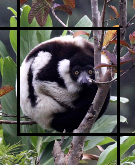The Javan Ebony Langur! One of our main targets spotted in Gunung Gede National Park, Java Barat.
***
Java Barat!
***
Please check out our Pbase galleries for more images of Indonesia!
Mammals of Java Barat
Birds of Java Barat
People & Places of Java Barat
Other critters of Java Barat
***
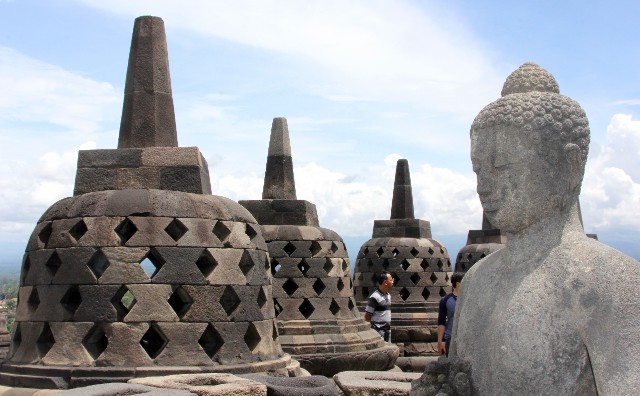
We were lucky enough to spend a very nice morning strolling the spectacular Borobudur Temple after our amazing wildlife adventure in western Java.
***
I am still in a bit of shock being back here in Ujung Kulon after all these years. After my first couple times of visiting Indonesia, I just assumed that I was never to return, especially to someplace as remote and expensive-to-get-to as Ujung Kulon. But here I am, with Cokie and Som, resting after a couple long days of some pretty impressive, albeit slightly frustrating, wildlife watching, Indonesia style!
We’re on our third day of our 21 day expedition now and we already have at least 17 species of mammals under out belts! Eighteen if you count the little mouse who was nibbling at my feet during the night! We’ve been working hard for some pretty frustrating sightings, but the experiences have been rich nonetheless. I knew that coming in the rainy season would be challenging, but I have been a bit surprised with how terrified many of the animals have been. I would suspect that poaching is a significant problem here still. The dense foliage in the forests has made quality sightings elusive in some instances as well.
Our tour operator for this expedtion was "Panca"from IF-EcoAdventures. (Website Here) I can highly recommend their services. The trip was pretty much flawless in its execution and we were treated very well throughout. Good mammal guides are very hard to find in Indonesia, but Panca and his staff have a wide range of contacts and were able to get us in to the appropriate areas for our targets. Once there, we were able to spot most of the species we wanted. Prices are high in Indonesia for what you get, but I am quite confident we got a good value for what we paid. Here is Panca's email: cs@if-ecoadventures.com
After an uneventful flight from Shanghai via Seoul, we arrived mid evening in Jakarta, which only seems to have gotten worse on the traffic, congestion and pollution fronts. There are few cities anywhere that have the insurmountable problems that Jakarta does. Our soon-to-be home, Bangkok, unfortunately may be one of them…
After a slightly restful evening in a very overpriced and very substandard hotel (name already forgotten!) we woke at what we thought was 5:30 AM and packed up and proceeded to wait in the lobby for our driver who never came!!! Over an hour of waiting and still nothing…. I was getting more than a bit pissed, but I could not help but notice that it was not getting light! According to Som’s iPhone, it was already 7AM, but still no light. What the &$^%? Since when did Indonesia have perpetual darkness?? Oh wait a minute (quick glance of the clock on the hotel lobby wall), it’s only 4AM!!! Som’s phone never caught a satellite and was still on Shanghai time! Nice….
Our drive to Carita, the launching off spot for Ujung Kulon, was uneventful and we had a nice brunch of some awesome seafood along the way. The road was under construction for much of the latter half so, what should have been a two hour drive ended up being closer to four. But we made it to Carita in time to make a mid-day cruise to Ujung Kulon. Our private boat, with a crew compliment of two, plus our guide, Changlus, and our driver, was adequate for the crossing and for shuttling around the region quite nicely.

First, before our expedition, some great seafood in Carita Beach!
Ujung Kulon National Park

Ujung Kulon as seen on our initial approach after a five hour bumpy cruise from Carita, Java Barat.
Ujung Kulon is normally about 3-4 hours slow cruise from Carita. The trip is very scenic and on previous trips, I spotted Pacific Humpbacked Dolphins, but today was a bit choppy with sporadic squalls that made for some fun cowboy-style boating! We all got pretty soaked for sure, but at least there was a dry spot for the gear.
I was hoping to get some snorkeling in for Cokie and Som but the seas appeared to be a bit too rough, but just as I was assuming there could be a missed activity, the seas calmed and we found a nice shoal for a quick dip. Far from a pristine coral reef, it was still nice to get Cokie his first warm-water snorkeling experience. His only other experience was in the cold waters of Baja. This reef was pretty beat to hell, with probably anchors being the main culprit, but we did spot a few dozen species of some spectacular reef dwellers. Cokie was addicted for sure. Som was pretty impressed as well. I only hoped I could find them a better experience in the coming days.
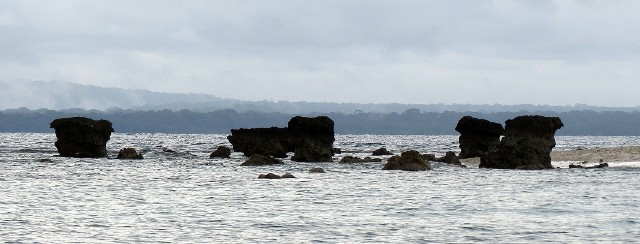
We snorkeled here for a couple hours on our first afternoon. Some good biodiversity for sure, but the reef was a bit beat up...

Cokie's first solo snorkeling experience!
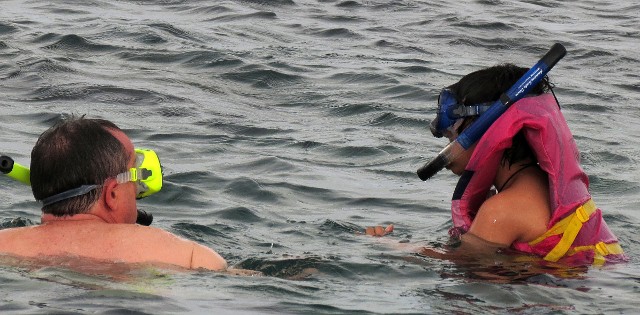
A little tutorial from dad...
Our first afternoon in Ujung Kulon was spent on Handeuleum Island where we stayed at the government housing. Very basic but there was electricity later in the afternoon and there were mosquito nets and it was dry! Luckily mosquitoes were light and the weather was no overwhelmingly hot. We got in a short trek to a grassy clearing in hopes of spotting some Banteng, but aside from a Plantain Squirrel (Sciurus plantain), we didn’t spot much else.
Plantain Squirrel (Sciurus plantain)
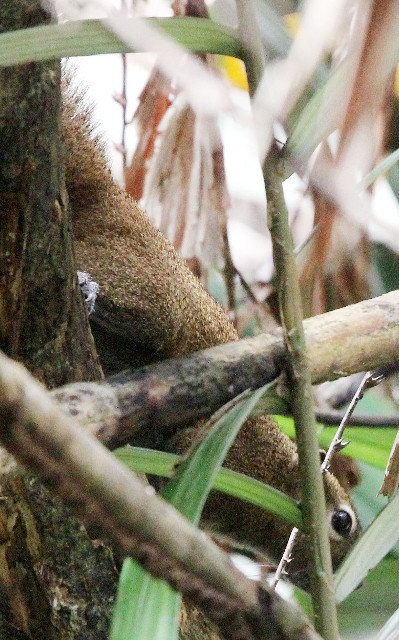
Plantain Squirrels (Sciurus plantain) were pretty much our first mammal seen at Ujung Kulon. The forest was full of scurrying little brown, furry critters, but most eluded identification...
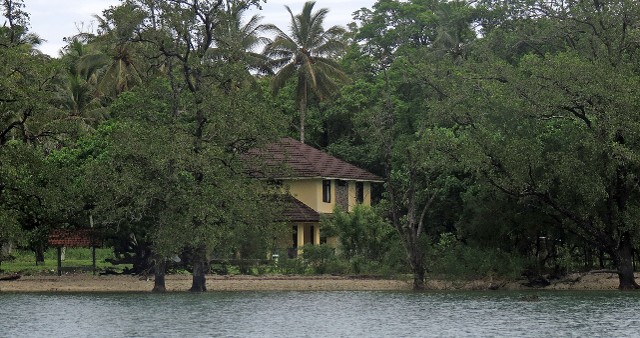
Our "home" at Handeuleum Island, Ujung Kulon. Basic lodging but more than adequate, and we had our very own Lesser False Vampire Bats in our room as a great perk!
Back at the headquarters we did get a few nice Lesser False Vampire Bats fluttering around our room for good measure. But our main goal was to canoe one of the local rivers in search for our main target, the Javan Rhinoceros. The river was quite full and flowing very fast, so in the narrow or shallow areas, the paddling was challenging. We did manage a few kilometers penetration in to the heart of the core area of the park. The forest was spectacular and actually quite full of wildlife. We spotted several troops of Long-tailed Macaques and Javan Surili (Leaf Monkeys) (Presbytis cristata) were seen all over the upper canopy of the forest gallery. We did spot another species of squirrel as well on the way out of the forest but the ID will forever remain a mystery… It was definitely not a Plantain Squirrel however…
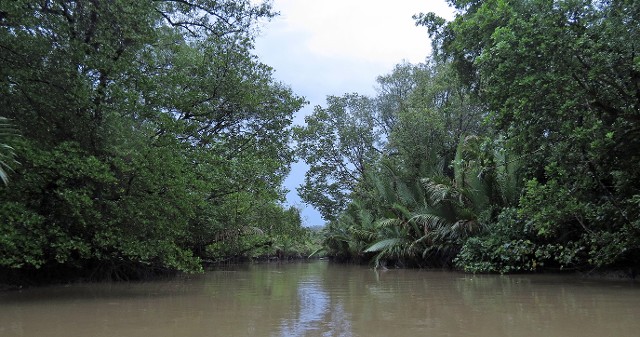
We canoed deep in to the interior of Ujung Kulon following the swollen streams and tributaries. Unfortunately Javan Rhino do not like swollen streams...

"Team Ujung Kulon!"
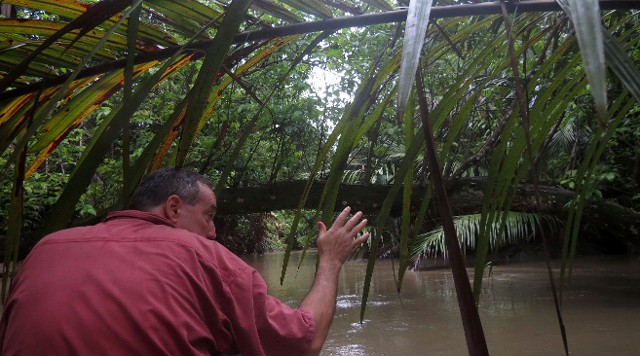
After a few kilometers, the streams became increasingly impenetrable...but more filled with fauna.
Long-tailed Macaque (Macaca fascicularis subspecies)
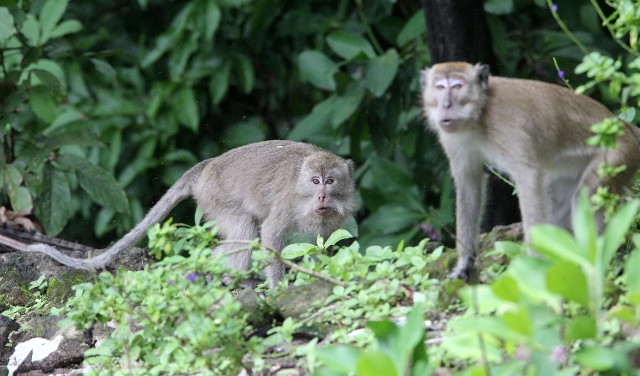
We were greeted by the omnipresent Long-tailed Macaques in Ujung Kulon. Interestingly, these fully grown macaques are far smaller than their cousins further inland. I noticed this years ago and still wonder if they are a unique subspecies.
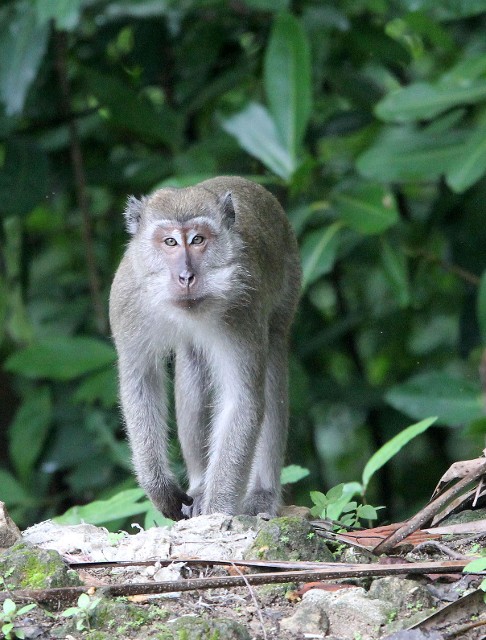
"Mini" Long-tailed Macaques of Ujung Kulon!
We dipped on the Rhino. Changlus, who had seen the Rhino four times over the years he’d been a guide, was sure the river was simply too high and fast for the Rhinos, who evidently prefer to take their morning dips in calm, slow moving streams… He was evidently correct. We did catch some great sightings (albeit in very poor light) of dozens of Javan Grizzled Leaf Monkeys in the canopy of the forest surrounding the stream we canoed. This cruise was very productive for this species as well as many still-unidentified squirrels.
Grizzled Langur (Presbytis cristata)

Javan Grizzled Leaf Monkeys were everywhere in the streams that coursed their way through the forests of Handeuleum Island. There seems to be confusion on the exact taxonomy of the Javan langurs, so please feel free to correct or ammend!

I just wish they would have stuck around long enough for a decent image!
Changlus thought it best to switch locations as the activities in and around Handeuleum Island were limited by the condition of the rivers. So we packed up and sailed another hour down the coast to Peucang Island, which is the spot I stayed so many years back. The place pretty much looked the same as it did in ’96, and I would bet that there had been no maintenance on any of the infrastructure since then either!
Still it was nice to be back here again. After a bit of room jostling, we finally ended up in the relatively nice Fauna bungalow, which has far nicer rooms than the Flora building. Be sure to ask for Fauna if planning a stay in the park. Evidently there had been some issues with the privately owned tourist concession and the national park service and the nice restaurant that once had fresh food and cold beers was now out of commission! Damn!
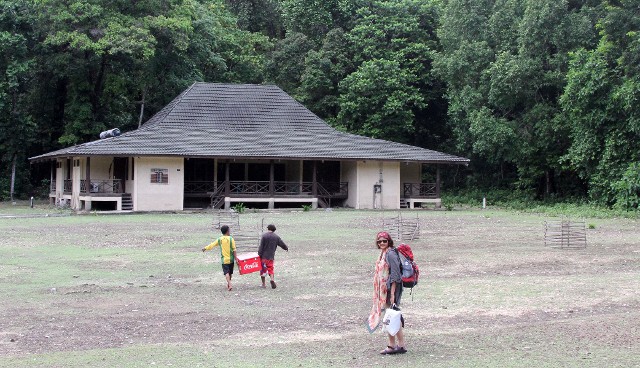
Heading to our new home for the next four nights...."Fauna B"...We owned this entire villa during our four nights at Ujung Kulon!
Our day was concluded with a nice trek to see the resident herd of Banteng that are found in a grassy clearing (Cidoan Grassland) directly across the channel from Peucang Island. Evidently they are generally very easy to spot at that clearing on a near daily basis and only during times of large tourist traffic do you take a chance of missing them. We were trapped by a major tropical downpour for about an hour but it was nice to simply hang out and watch the Banteng enjoy the cool shower. We did catch a quick glimpse of a Palm Civet as well in the palm forests adjacent to the grasslands. Such fleeting glimpses seem to be the theme of this trip….But this civet was very different. It was beige to slightly grey and was absolutely not the Common Palm Civet that is much more common there. As we did not get an image, and our guide had never seen that species before, we still don’t have a clear idea of the ID. It is possible that it was a Javan Small-toothed Palm Civet, but…
Javan Banteng (Bos javanicus javanicus)

I am thinking that this herd of Banteng has not moved in over twenty years! Still there and still being spectacular...

Over 30 individuals were in the grassland this afternoon.

Green Peafowl are known to be the best friends of the Banteng.
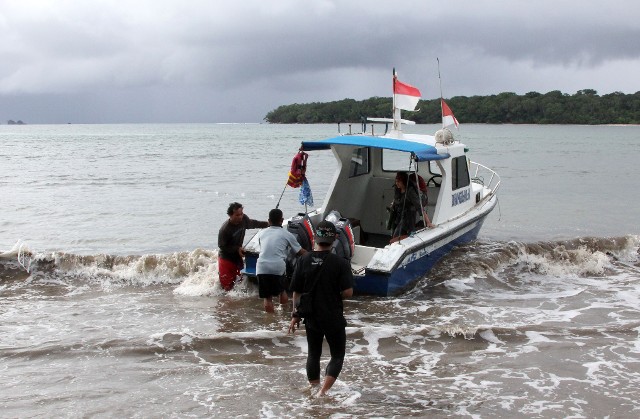
The trip to the grasslands on the mainland was pretty easy but getting out of the boat was treacherous. The dock that used to be there was pretty much decomposed and gone now, so we were at the mercy of the surf...
Our next morning was an early one. Up and on the boat at 6:30AM for our trek to the famous “Rhino Central” region of the park’s core area. About 7.6 km in to the park was a spot where evidently many Javan Rhinos were known to cross daily and if there was a chance at all of seeing one or even sign of one, Changlus thought this was it. Luckily he never told me how far it was or I might have opted not to go….Getting old you know!
The trek was not exactly challenging, but the heat and humidity made it so. We only had one minor hill to climb but the trail was extremely muddy and slippery and filled with thorny vegetation. At one point Som took quite a spill and stabbed herself with a bamboo point! Lots of blood and a good gash, but she would survive. We did pretty good with wildlife on the way to Rhino Central. We caught some definite Giant Squirrels (Ratufa bicolor) but the coloration of these individuals is so different than anything I have seen in other locations or in the literature. There is something definitely unique about the Giant Black Squirrels of Ujung Kulon! I have come across a few resources that mention a “Javan Squirrel” (Sciurus javensis), but I am not sure at all about the validity of this name.

I use the term "trail" loosely....
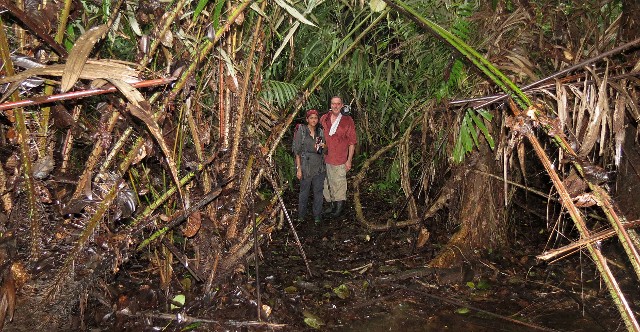
It had been months since this trail had been used evidently. Consequently it was overgrown with my favorite tropical plant, rattan....Crap.
Javan Black Giant Squirrel (Ratufa bicolor bicolor)

The Javan Black Giant Squirrel is very different than other Black Giant Squirrels seen elsewhere in Asia. Note the sandy tail and completely UN-black body. I am thinking some revision may be in order.

Interestingly though, there were others that definitely did have a blacker mantle but still that beige tail bothered the hell out of me...
We did catch some distant and fleeting glimpses of the spectacular glossy black Javan Silvered Leaf Monkey (Lutung) (Trachypithecus auratus cristatus), both on the trail and on the summit of the only hill we climbed. Very cool to see these spectacular primates once again (I had seen them from our boat near the Ujung Kulon light house so many years ago). There is in my mind a great deal of confusion about the taxonomy of Javan leaf monkeys, so I am very hopeful that someone reading this report can correct my nomenclature if possible. Som and Cokie were on a Javan Mouse Deer (Tragula javanicus) spotting marathon, each seeing several. I saw none… We did all get some good looks at some more Plantain Squirrels jumping about in the rattan thickets.
Glossy Black Javan Silvered Leaf Monkey (Lutung) (Trachypithecus auratus cristatus)
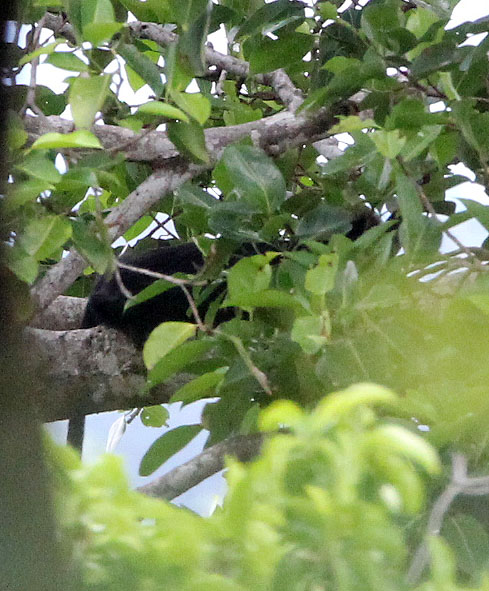
Javan Black Glossy Silvered Langurs were viewable in Ujung Kulon but only very briefly and very distant...Sorry for the bad image...Again, please feel free to correc the taxonomy...
"Rhino Central"!
Once we made it to Rhino Central, Changlus was proven correct. There was sign of Javan Rhinoceros everywhere. It reminded me a bit of a wild Grizzly Bear habitat with loads of tunnels where the large animals would course their way to and fro… At one point we saw a very fresh track and entry point in to the river passing through the area. I was very excited to see such a fresh track, clearly made only a couple hours prior to our arrival! I just wish Changlus had not stepped on it before I could take a picture! A nice fresh turd later, we were clearly aware we were in “Rhino Central”!
Since we arrived in the area in the heat of the afternoon, it was not surprising that there was little activity. We relaxed a bit on the beach of the South Coast, which faced the open Indian Ocean. The sea was surprisingly calm and the wilderness from our vantage point seemed to stretch forever. For a brief moment, we could get the feeling and what the entire Java Island would have looked like before humans. I envisioned the grassland filled with grazing rhinos and banteng…..We relaxed under the Pandanus trees for a bit before deciding to trek back to civilization. Ugh!!! We were not looking forward to the 7.5 km trek at all.
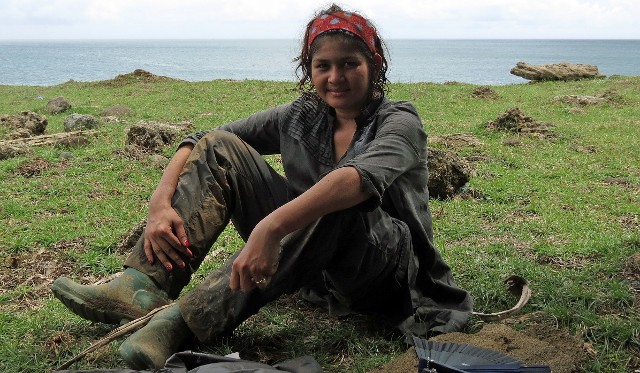
Taking a needed break at "South Shore" of Ujung Kulon...
We finally mustered up the energy and enthusiasm to start our trek back. We slowly re-entered Rhino Central and I led the pack. About a couple hundred meters in to the rattan forest, I started to get that sensation again: that sensation that something was watching me. I was thinking to myself how cool it would be if a Rhino were in the brush….and then, “Grunt”! Thrash! Stampede! Thrash! Silence…. I could not believe it! There was a giant Javan Rhino no more than five meters beside me as I was walking past! He evidently thought I was close enough and he decided to bolt! One can never understate the sound and sensation of a large megafaunum stampeding directly next to you!
All I caught was yet another fleeting glimpse of a large shadowy (more like a silhouette) animal rushing and displacing the forest directly beside me and then across and behind me off in to the impenetrable rattan thicket. Initially I was alone but Som and Cokie were right behind me. “Did you hear that?” I asked! They did and wondered what the hell that was. “Rhino baby!” “We got our Rhino!” Well, of course I would have loved to have seen it wading in a stream in good light with time to change lenses and positions, etc., etc… But beggars cannot be choosers! To be so close to one of the last 34 of its kind is a privilege that I will never forget.
Javan Rhinoceros (Rhinoceros sondaicus)!

Since I was not able to snap my own image of the very fast Javan Rhino that was only 5 meters to my left, I will simply insert some pics from the ranger station...Not sure if I will ever get back to get my own pics again! Who could be so lucky to see it twice?
Immediately after the stampede, we searched for clear sign that would prove to all parties that we had just seen a Rhino, and it was pretty easy to find. I could tell that Changlus did not want to know he had just missed a rhino, but the fresh tracks and rebounding brush in the direction of its departure were clear indicators that a Rhino had just passed through. We were all pretty excited! That was until we remembered we still had over 7 km of trekking to get through….grr…

We confirmed the stampeding beast was in fact a Javan Rhino to Changlus's satisfaction with the ample sign and tunnels carved in to the rattan thickets...

What a rare privilege!
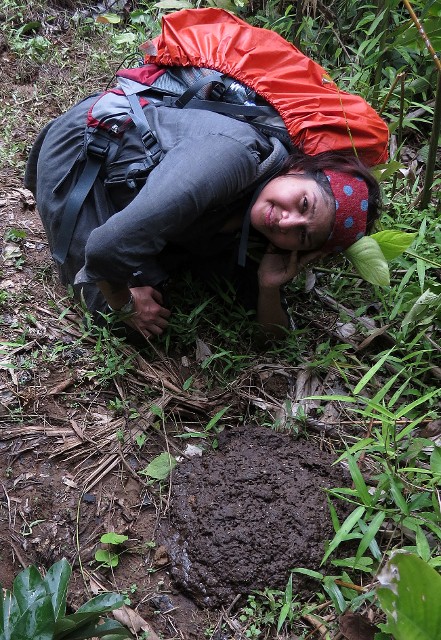
Som getting a face full of....Rhino dung! Evidently we caught the rhino taking a dump....

Som earned this sighting by mpaling herself on a sprig of bamboo on the trail. It's looks worse than it was...At least that is what she told us...
Sore and exhausted as we found out way back home to Peucang Island. We still basically owned the entire national park, and we toasted our good fortune to some bottled OJ. Watching the hornbills and flying foxes fly overhead, we all felt pretty lucky to have had such an experience on our second day in Ujung Kulon!
We were feeling our bones on the next day at Ujung Kulon. The 16km hike took its toll for sure. So we spent a leisurely morning around the compound and relaxed for a bit before taking a very leisurely cruise around the island and peninsula to check out the light house and then search for some marine mammals and fresh fish for dinner. There weren’t too many fishermen out and about so it took a bit of effort but we did finally manage to get some fresh tuna for dinner. This is one of the things I love most about traveling by boat in Indonesia – all of the fresh seafood. I just wish they could cook it with a bit more flavor

The local fish market....a passing fishing boat...I wonder what they have?
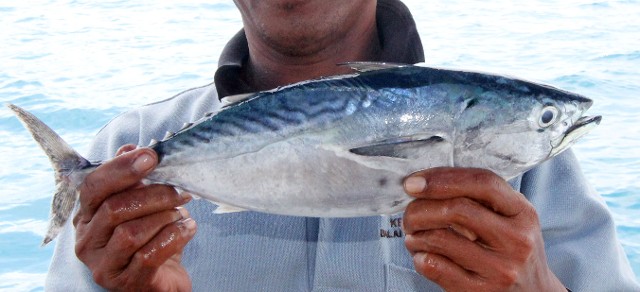
Fresh tuna!
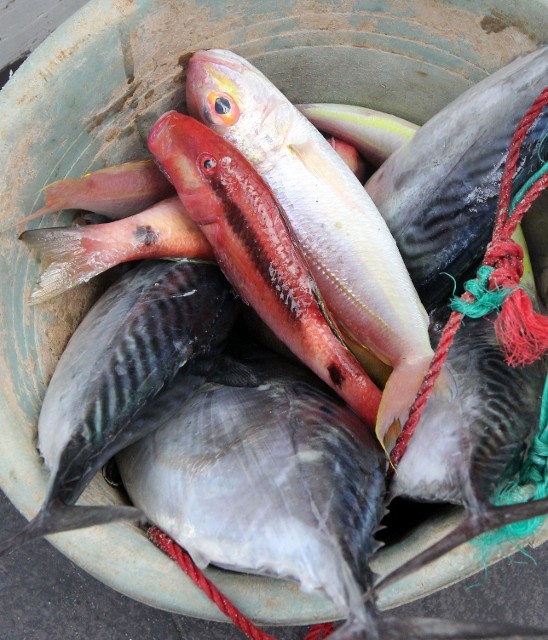
We ate like kings this evening!
After the seafood shopping spree, I trekked the trail on Peucang Island for a couple kms. The forest was spectacular and there was a lot of wildlife, albeit nothing too new. Interestingly though the same species that would come up to you and beg a handout in the compound, the deer, boars, macaques, were terrified of you in the forest. I guess humans in one context meant food, and in another meant poacher!
Large Flying Fox (Pteropus vampyrus)
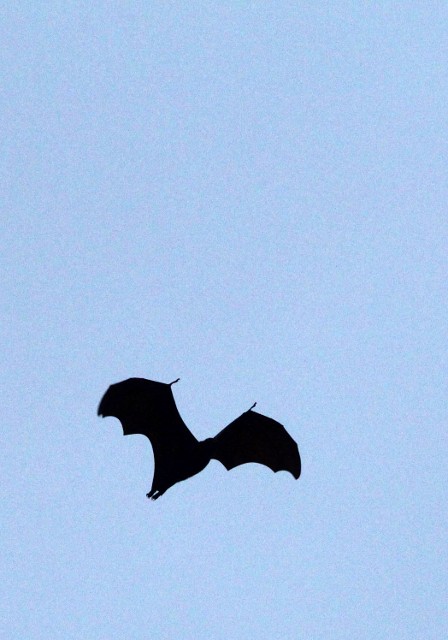
We were treated to a nightly explosion of Large Flying Foxes while resting on our veranda at Peucang Island...
Sundaic Banded Pig (Sus scrofa vittatus)
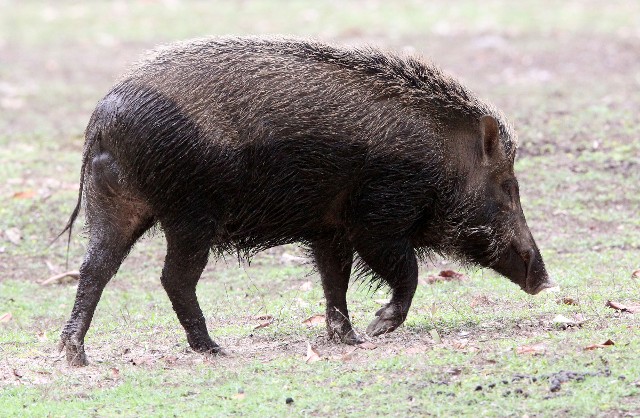
Thought by some mammalogists to be a distinct and endemic species, the Sunaic Banded Pig was a common neighbor on Peucang Island. Many would visit every morning and evening for handouts from the staff and travelers. They are more commonly considered to be a valid subspecies of the widespread Wild Boar group.
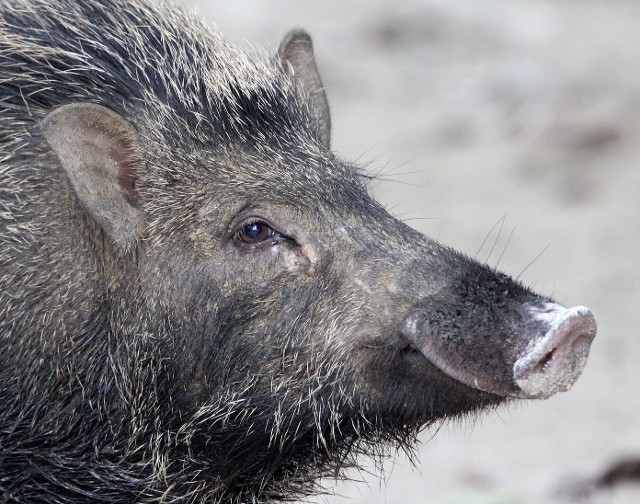
Mostly females were found at Peucang

Sundaic Banded Pig (Sus scrofa vittatus)

Little ones were also visitors to our camp...
Javan Rusa (Rusa timorensis russa)
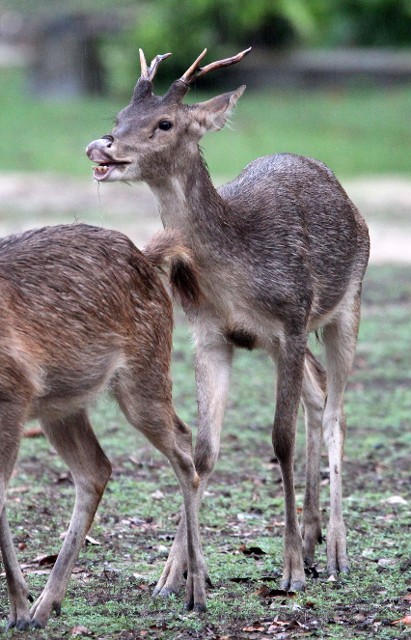
Javan Rusa Deer (a redundancy as "Rusa" means "deer" in Bahasa Indonesia...) were very common in the camp at Peucang. Every evening we were graced with the presence of at least 40-50 individuals!
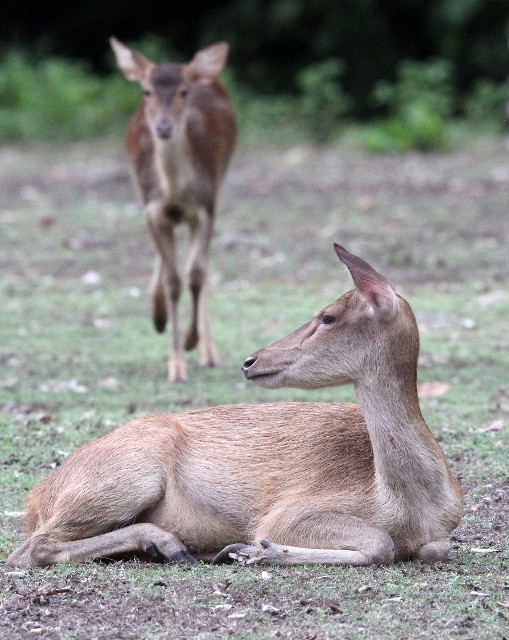
Javan Rusa
I tried to get a canoe ride in to the forest but was informed that it was forbidden as it was closed for camera trapping. This is one thing to be very careful of when planning a trip to Ujung Kulon – evidently they can and do close the trails at a moment’s notice, and you may make the entire trip out here for nothing. Many of the trails were in fact closed this trip but we were fortunate to hit the one trail that was open and actually come across a rhino! I could tell that one of the rangers back at the compound was a bit annoyed when I told him we actually came across a rhino….
But we did get a nice night trek in across the channel in by the grasslands with the Banteng. We came across a Common Palm Civet which we watched for some time chewing on himself… But the highlight of the night, aside from Som getting smacked right in the face by a large flying fruit bat, was our time spent with a large Javan Binturong (Arctictis binturong penicillatus) perched high in the forest canopy! Evidently this is a rare species in Ujung Kulon and our guide had never seen or heard of one. It was pretty high up in the canopy so good images were a challenge, but we did get enough to confirm the ID.
Javan Common Palm Civet (Paradoxurus hermaphroditus javanica)
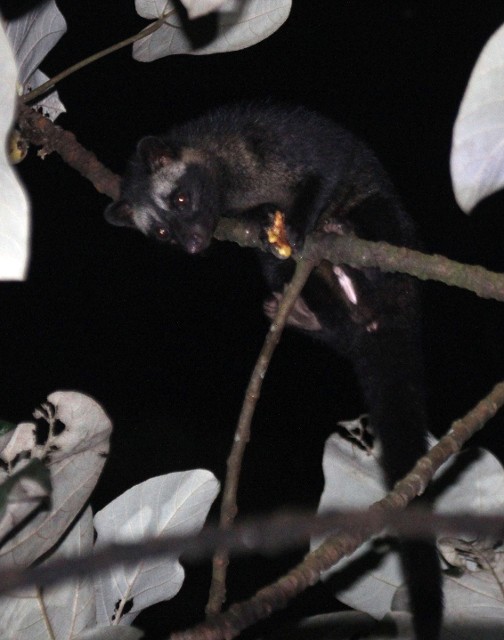
Javan Common Palm Civets were very commonly seen at night throughout our expedition to Java Barat.
Javan Binturong (Arctictis binturong penicillatus) 
We spent a considerable amount of time trying to get a better look at this rare Javan Binturong. Initially we identified it as a Cuscus, but soon learned they did not exist in Java Barat....
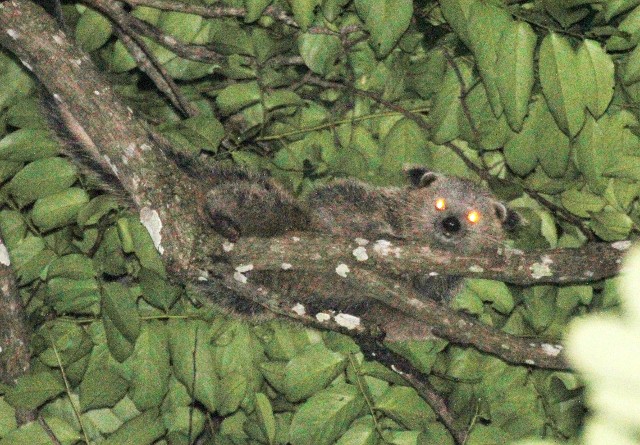
Javan Binturong!

There is no doubt that Ujung Kulon has some of the nicest beaches anywhere. Our relaxed 4-day schedule there allowed for the perfect amount of wildlife-viewing, trekking, and relaxation time!
Krakatau Island (Krakatoa!)
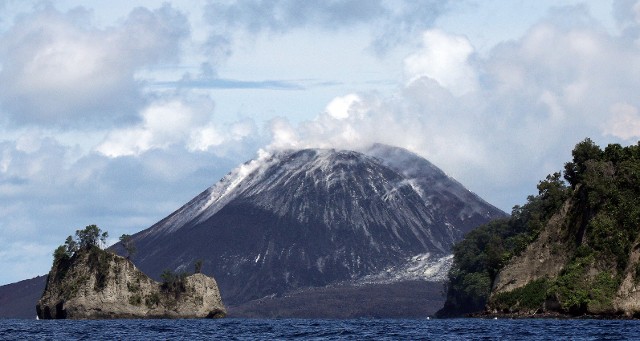
Krakatau!
An early start and off we were for Krakatau Island, one of the world’s youngest, which is a couple hours speed boat ride toward the island of Sumatra. I never managed to get there on my earlier trips so it was nice to finally make it. It was a sunny day so the trek over the lava-sand beach and trail to the base of the mountain was intense to say the least. In fact the heat was so overwhelming that I couldn’t get out of there fast enough! I was impressed however at how established the Ironwood (?) community was at the eastern edge of the island. There were at least a dozen species of plants present and the simple ecosystem was starting to show elements of complexity. There were at least lizards on the island but I am not sure about mammals, although I did hear that there were some monkeys there until a big eruption some time back.
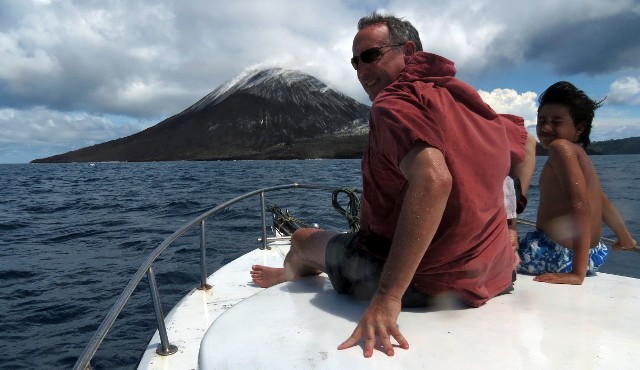
Our approach to Krakatau...Spectacular day!
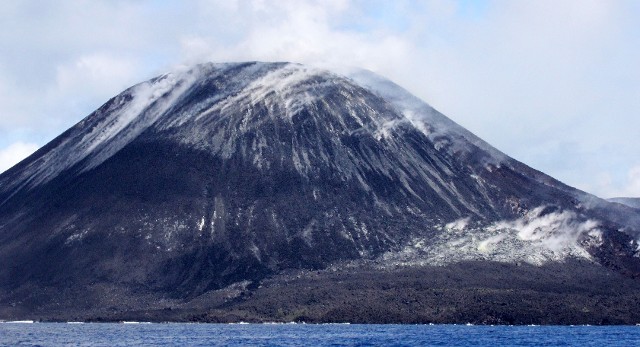
I had no idea it was still so active. Next time I want to come at night!

Very active!
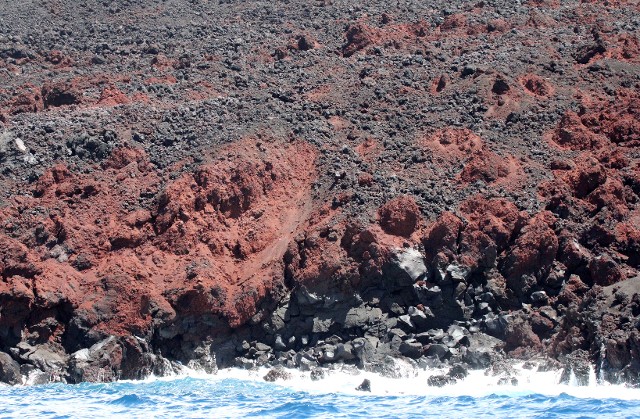
Fresh red basalt...
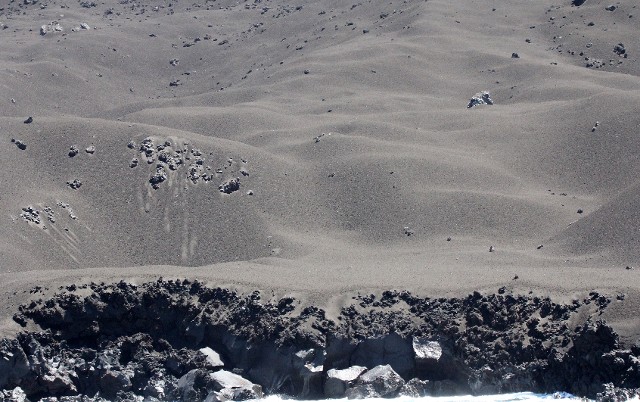
Fresh earth!

Cokie and I took a very hot trek to the burn zone on Krakatau. It was simply too hot and gaseous to continue further up...

I wish I could have shared this stop with my IB and AP kids - primary succession example on steroids!
After a whirlwind tour of Krakatau, we spent some time snorkeling in the nicest coral reef we seen on the trip to date. Much more pristine than the other two, this reef was situated on the volcanic basaltic outcroppings, which made it particularly interesting. We caught glimpses of at least four different clownfish species as well as at least four dozen other spectacular marine fish and invertebrate species. I particularly enjoyed teasing Cokie and Som with the sea cucumbers I plucked off the sea floor! A couple sour notes for the day were the sea jelly stings I suffered as well as the near deadly sunburn that about 1 hour in the intense Java sun got me!
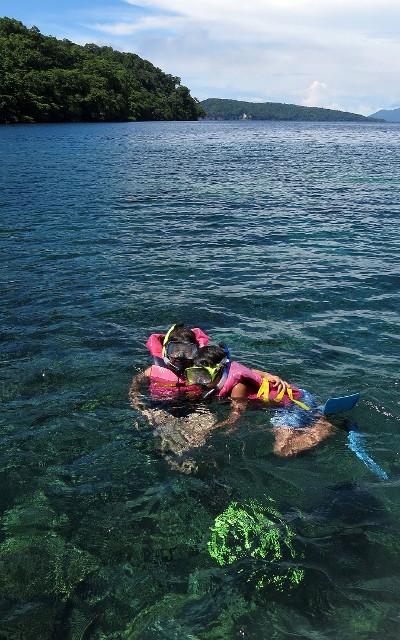
Of all of the snorkeling stops in Indo this trip, the lava reef off of Krakatau was the best by far!
An evening in Carita Beach was nice, with some killer Indo grub and finally some ice cold beer! The seafood in Indo is tough to beat for sure! I guess you need to know what to order, as much of the cuisine in Indonesia is very plain and tasteless, but when you get some of the good stuff, it can be very good in deed.
***
Taman Nasional Gunung Gede
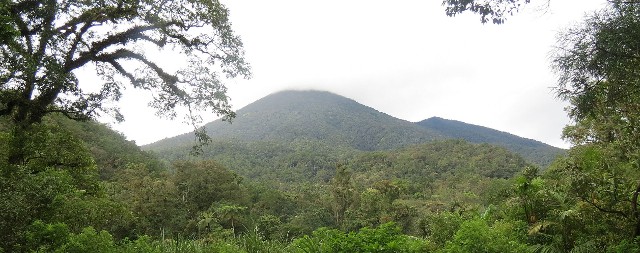
Gunung Gede National Park
Now off for some new species deep in the interior of Java, with our first stop being east of Bogor at Ciboda. Nestled high up in the tea country of Bogor province, Ciboda and Gunung Gede National Park are home to many interesting species. Our first afternoon was spent searching for squirrels and Javan Ebony Langurs (Trachypithecus auratus auratus). Sadly we were not to have much luck with these with the exception of several Black-banded Squirrels and some Long-tailed Macaques, which were definitely larger than their Ujung Kulon cousins. I did catch a fleeting look at a Red Giant Flying Squirrel flying between some of the larger trees remaining in Ciboda Botanical Garden. And aside from a couple mystery squirrels, we all got a good look at a scurrying Lesser Gymnure dashing across the road! A very cool shrew for sure.
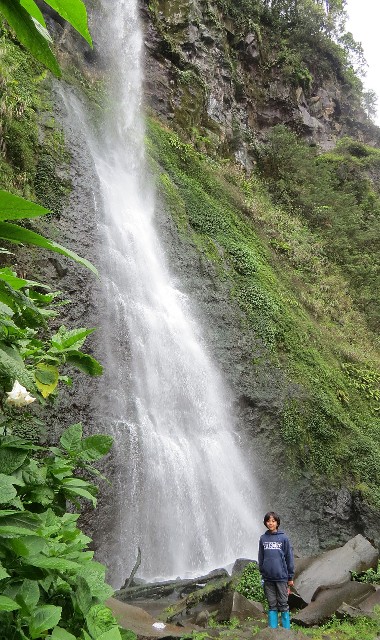
Cibodas Falls, Gunung Gede National Park
Black-striped Squirrel (Callosciurus nigrovittatus nigrovittatus)
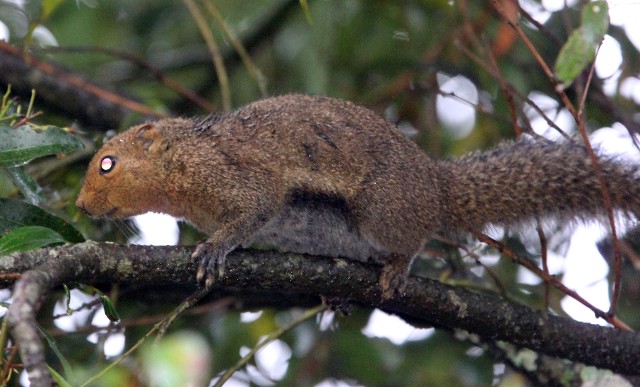
Black-striped (Common) Squirrels were very common in the Cibodas Botanical Gardens as well as Gunung Gede National Park. In a simple stroll around the gardens, we came across several.
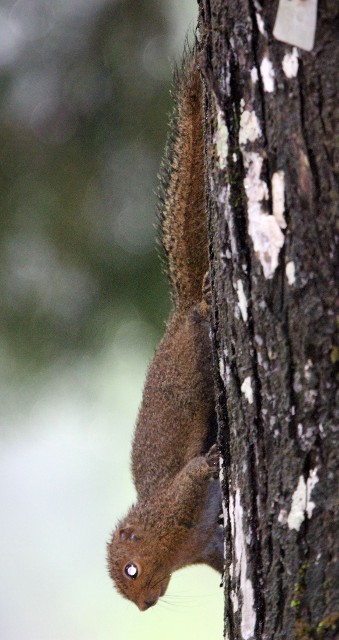
Black-striped Squirrel at Cibodas.
Being in any popular destination in Asia during the rainy AND holiday season is a challenge. Hoards of littering, yapping, karaoke-singing nature haters is a bit tough to take when trying to experience nature and view wildlife. This has been our experience in such places like Thailand and China, but so far in Cibodas, it hasn’t been too bad. Today we had a trek up to the Cibodas Waterfalls of Gunung Gede National Park, and there were only a couple hundred people on the trail with us. Luckily, our guide and spotter, “Eddy”, son of the famous “Freddy” of “Freddy’s Homestay”, was wise enough to suggest we get a 6AM start up the mountain to avoid the tourists. And for the first couple hours, we had the entire place to ourselves, which made for a very relaxing and spectacular trek through the forests of Cibodas. But I do mean we had the entire place to ourselves! Not even a common squirrel to share space with. I was hoping that this morning’s trek would be productive, but at least at the onset, it appeared to be a skunk-fest!
Our main targets for the morning were the Javan Gibbon, Javan Grizzled Leaf Monkey and the Javan Ebony Langur. We trekked for about two hours before we encountered one of them – the Javan Ebony Langur (Trachypithecus auratus auratus). For the day we came across at least three separate troops of these nicely hairstyled-primates and were able to get some decent images. As some of the sightings were with many tourists, it appears that the Ebony Langurs were quite accustomed to having people around. We also got a very brief and blocked-by-foliage-view of some Javan Grizzled or Silvered Leaf Monkeys. And we finally got a Javan Treeshrew…. But no Javan Gibbons!
Javan Ebony Langur (Trachypithecus auratus auratus)
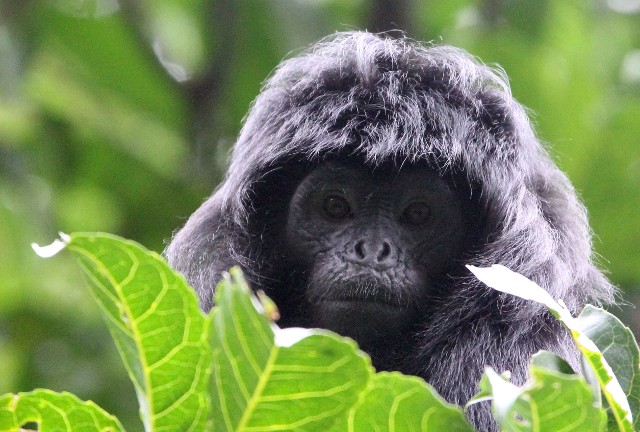
Javan Ebony Langur (Leaf Monkey) were easy to see at close quarters in Gunung Gede National Park.
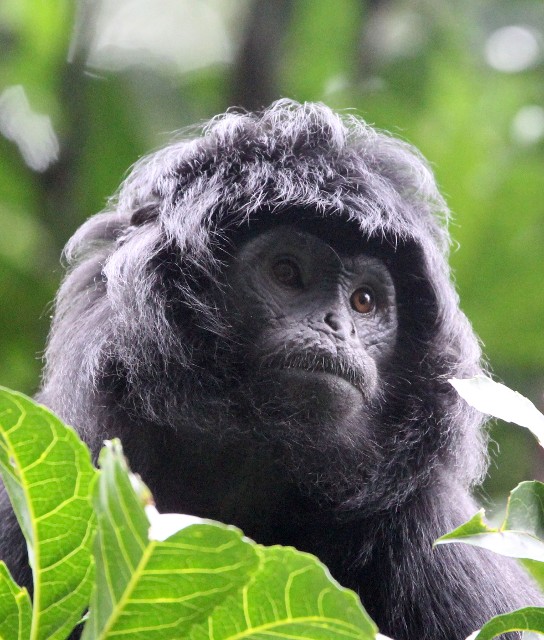
Javan Ebony Langur
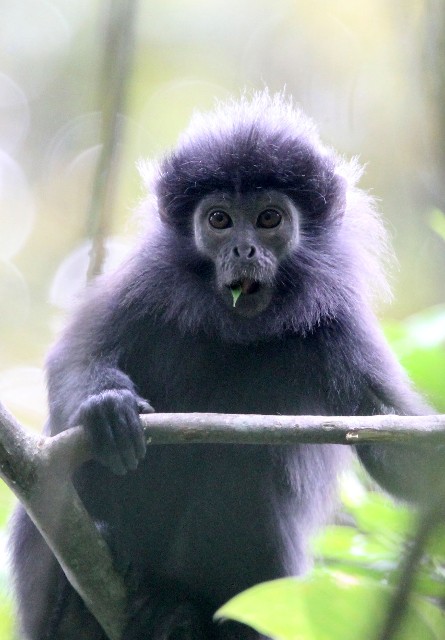
Little ones were common in the troops we came across...

They seemed as curious of us as we were of them.
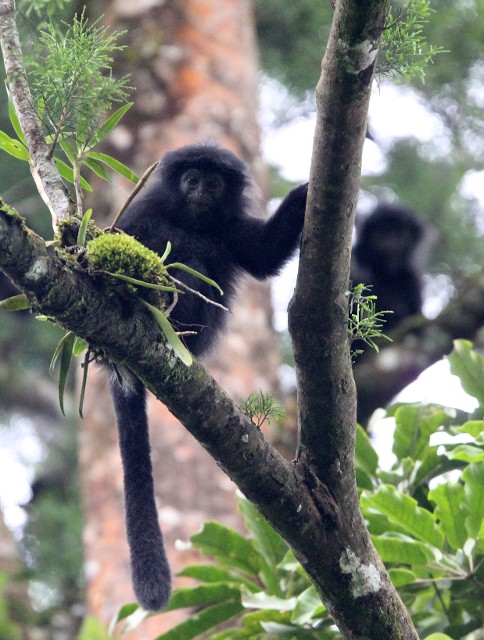
Hello!
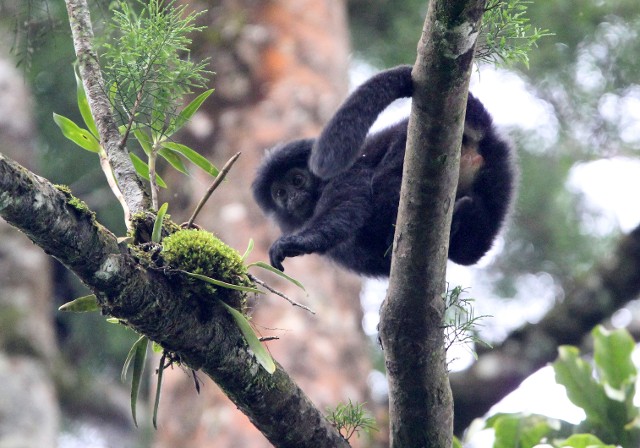
One more look before bolting!
Javan Tree Shrew (Tupaia javanica)

We were very careful not to ignore the little brown scurriers in the forest, as there were many potential species that were NOT the Black-striped Squirrels which were so common. We did manage a couple brief sightings of Javan Treeshrews with our efforts.
I am hopeful to get some good looks in the coming days at Halimun NP for the gibbons and the rest of our targets. The rain has been very challenging however. While I have always enjoyed tropical downpours, it is a bit of a different story when you are paying big bucks and have limited time to see things when it is raining so persistently. But at least we’ve seen what we’ve seen and had some relatively high quality sightings and experiences and now have a pretty decent species list considering. But if I were to do this trip again, I would seriously consider doing it in the dry season of July and August next time.
Taman Nasional Gunung Halimun

It did not take us more than a couple minutes after arriving in Halimun for Som (of course!) to spot our first Javan Gibbon (Hylobates moloch)! This one gave us a great show for several minutes.
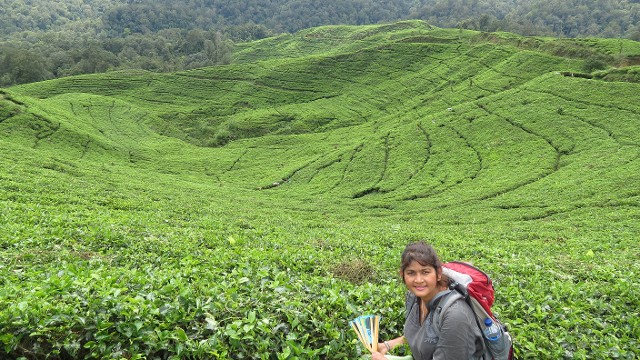
The heart of Gunung Halimun is a massive tea plantation.
So here we are at Halimun sitting in the drenching rain…. We were very lucky however that literally two minutes after we arrived, Som spotted some movement in the high canopy directly in back of our new home, the Research Center, and sure enough we had a few moments with no less than three spectacular Javan Gibbons! We had a great show for about a half an hour of one large and curious one with a couple smaller individuals hiding a bit more effectively in the foliage. What a great start to our Halimun section of the expedition! And then the rain started….It’s been pouring now for several hours with no signs of letting up. Indra, our excellent guide, seems optimistic though that we will still get our Javan Small-toothed Palm Civet this evening, in spite of the deluge.
Javan Gibbon (Hylobates moloch)

The Javan Gibbon (Hylobates moloch) is definitely one of the more spectacular in the gibbon group. They silvery-grey fur is very unique.

Without too much effort, we came across over 8-10 individuals and heard morning calling from at least one more group near the tea plantation.

Spectacular Javan Gibbon
Sure enough, in spite of the tropical downpour, our evening was filled with civets! Initially we were blessed with several Common Palm Civets on the two fruiting trees in the research station’s garden. At first I was hoping they were the rare Javan Small-toothed Palm Civet, and even tried to convince myself for a couple milliseconds that they were somehow different, but alas, they were definitely Common Palm Civets. So we decided to trek for a couple kms in the rain to see what else we could score, but aside from a pretty impressive little viper, we were skunked. The rain seemed to scare everything not-civet in to hiding…
Javan Common Palm Civet (Paradoxurus hermaphroditus javanica)

We were fortunate to see many more Javan Common Palm Civets in Halimun as well.

There were some Ficus trees with as many as 5-6 individuals at a time!
Som and I decided to hit the hay early to make sure we had some rest for the next day’s trek in to the Halimun forest, but I told Indra that if he saw anything else come in to the trees to be sure to wake us up. And sure enough, just as we were drifting off, “knock-knock”…I heard Indra say through the door, ”The other civet is here!” So we grabbed our clothes and cameras and proceeded to spend quality time with one of the most unique civets I’d ever seen. Not knowing what they hell were the key characteristics of a Javan Civet, I just assumed this one was it. But Indra and the research station crew was not at all sure that was the case. I will need to do some research myself it seems. The animal was very spectacular whatever species it ends up being.
Javan Small-toothed Palm Civet (Arctogalidia trilineata)

We had great and prolonged views of this spectacular Javan Small-toothed Palm Civet, which supposedly visits the fruiting fig tree of the research station every night.

Javan Small-toothed Palm Civet

Love those figs!
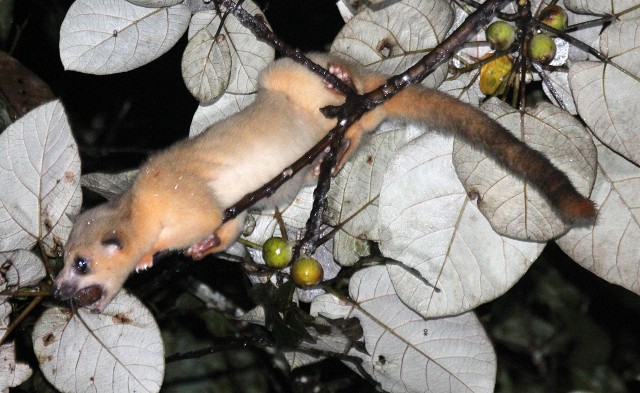
Going for seconds...

"Trail? We don't need no stinkin' trail!"
Satisfied now scoring mammal #30, we finally went to sleep and rested for our next trek. This was to take us on the so-called “Loop Trail” which basically amounts to about 3km in the primary forest and about 3km on the main road through the tea plantation that sits smack-dab in the middle of the core area of Halimun. I cannot believe how many spectacular forested wilderness areas we’ve visited lately that have been ravaged by tea plantations! Uganda, Rwanda, Ethiopia, China and now here in Java….Grrrr! Makes one want to give up tea!
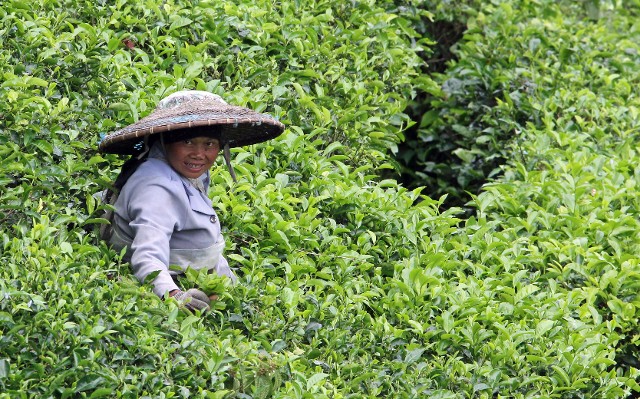
Halimun Tea...
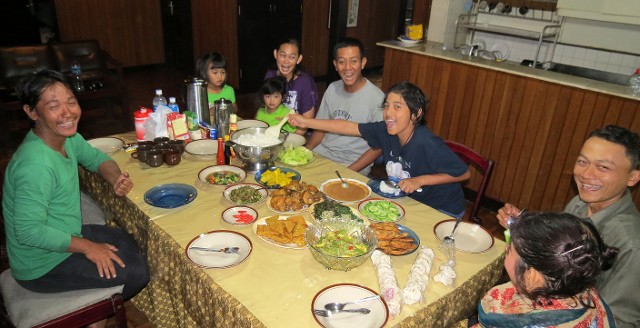
Our daily feast at Halimun Research Station! Panca and his family joined us and the food was fantastic!
Our targets today were better images of the primates we’ve seen already on our trip as well as trying to nail a Javan Mongoose and a Javan Black-eared Pygmy Squirrel, neither of which was to be accomplished during our trek through the otherwise very spectacular forest of Halimun. We did see another Javan Black Giant Squirrel (Ratufa bicolor bicolor) as well as several of the so-called “Common Squirrels” (Black-striped Squirrel (Callosciurus nigrovittatus nigrovittatus), which are by far the most common critter of the trip… We spotted, with Indra’s expert help of course, about 20 new species of birds, many of which were Java endemics. All in all it was a nice trek. Indra and I even revisited the tea plantation road in the afternoon in hopes of spotting a Javan Mongoose, but no luck. Other than listening to a couple singing and distant Javan Gibbons, it was not much more than sight-seeing. I guess the Javan Mongoose will end up being one of my “reason-to-return” critters…
Javan Black Giant Squirrel (Ratufa bicolor bicolor)
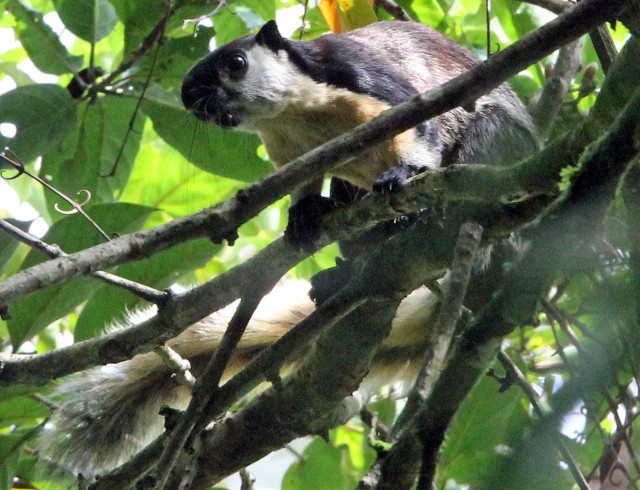
This Javan Black Giant Squirrel was seen near the trail's edge while trekking the "Loop Trail" at Halimun.
Black-striped Squirrel (Callosciurus nigrovittatus nigrovittatus)
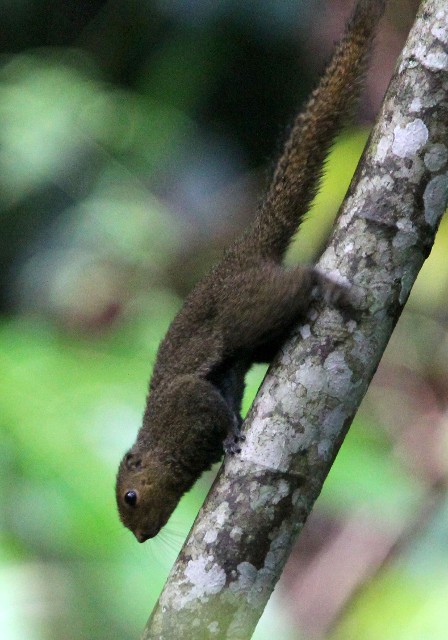
More Black-striped Squirrels were seen in the forests of Halimun.
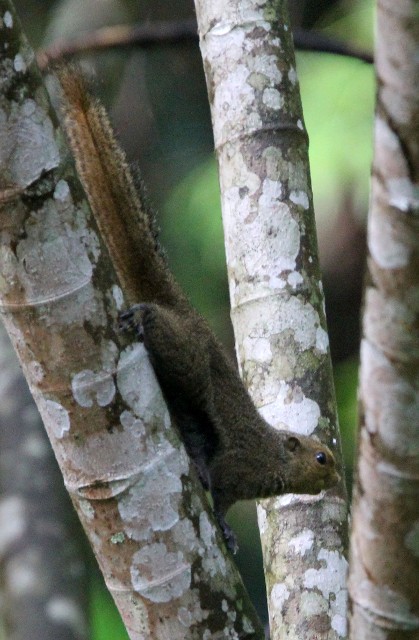
Black-striped Squirrel
So now I sit on the deck of this quite nice, Japanese built and funded, research station, which is now mainly for tourists as of a few months ago. So far no rain (miraculous) and we are looking to head out this evening en masse in search of the rare and most likely impossible-to-see Javan Stink Badger! Oh baby!
Our trip to West Java was much more productive and enjoyable than I could have ever predicted. The sighting of a Javan Rhino and at least 29 other species of mammals far exceeded my projections! Both Som and Cokie really enjoyed the expedition and we will now mark Java Barat as one of our travel high points!
I do worry about Indonesia’s nature and wildlife, however. I would be hard-pressed to find another country anywhere that cares less about its environment and its nature. Most of the people we came across, with several notable exceptions, such as our guides and other team members, seemed to hold no respect whatsoever for the amazing nature that their country possesses. The national parks are decomposing with infrastructure that is either non-existent or in complete disrepair. I was pessimistic 20 years ago when I first came to Indonesia in the early ‘90’s. Now I hold even less hope for a bright future for Indonesia’s flora and fauna. I sincerely hope I am wrong but the reality on the ground is not pretty. If you want to experience Indonesia’s nature, you’d better come NOW!
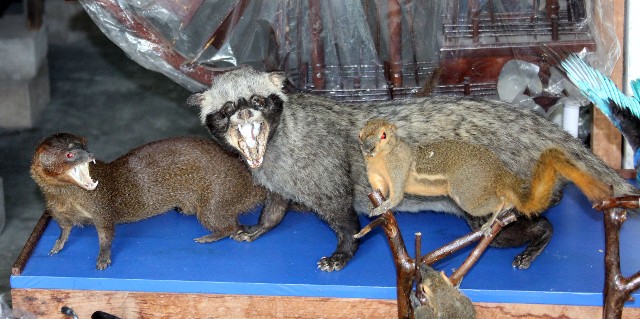
I was sad to see our only Javan Mongoose (on the left) and Three-striped Ground Squirrel (right) stuffed in the temple market in Jogja.
Yogyakarta, Central Java!
Borobudur Temple
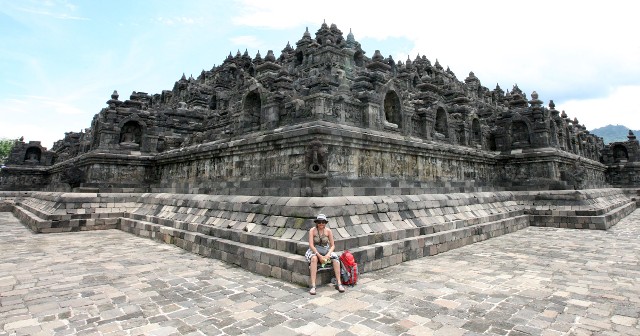
Som "owned" Borobudur for a short while....Until half of Indonesia came in on the buses around 9AM or so!
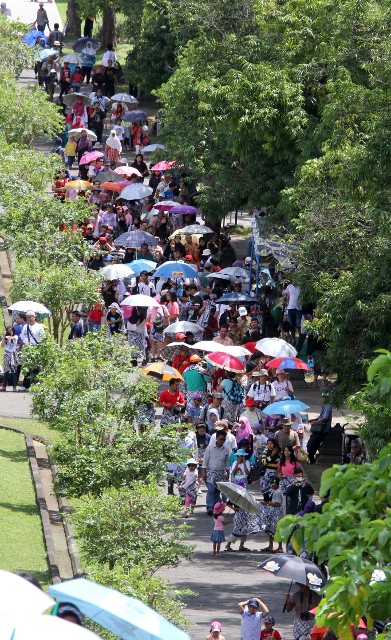
Here they come!
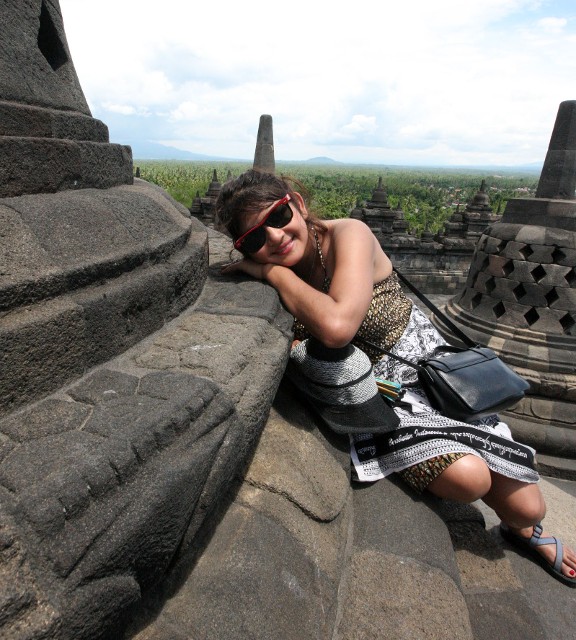
Relaxing on a scalding hot stupa....

Self portrait at Borobudur!

The bass reliefs at Borobudur were spectacular, although the daily deluge of humanity there must surely be taking its toll on the treasures...
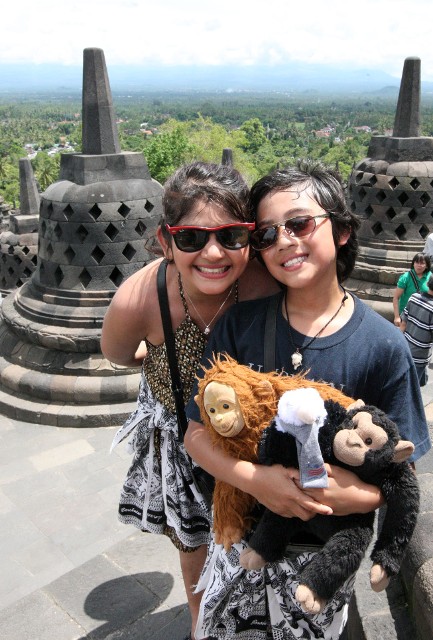
Goofballs! All four of them - Som, Cokie, Toby and Nyungwe the chimp...
Prambanan Hindu Temple
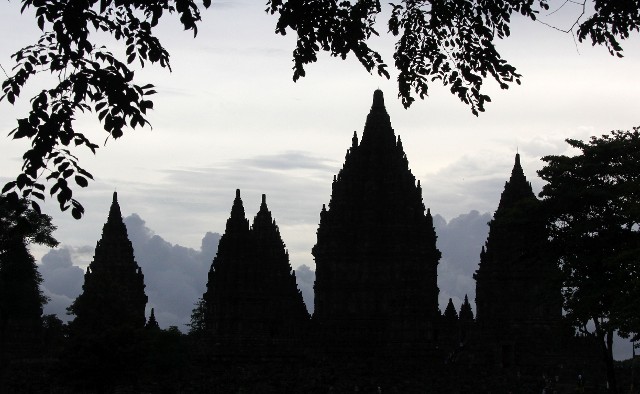
Prambanan Hindu Temple, Yogyakarta

Prambanan

Sunset at Prambanan

Som at Prambanan...

Dude!
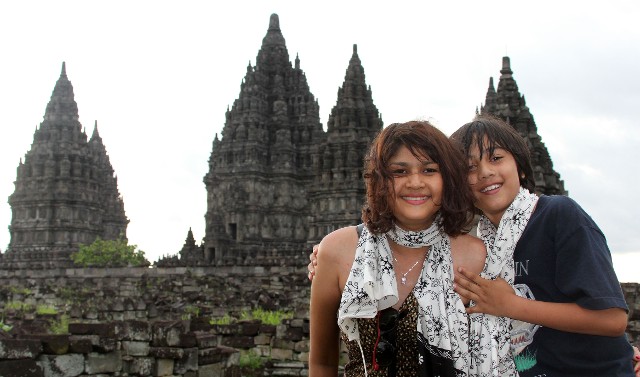
Now that is more like it!

Prambanan Hindu Temple
Java Mammal List
UK=Ujung Kulon, G=Gunung Gede, H=Gunung Halimun
Family Bovidae
- Javan Banteng (Bos javanicus javanicus) (Thailand = Bos j. burmanicus) UK
- Javan Mouse Deer (Kanchil) (Tragula javanica) UK
Family Rhinocerotidae
- Javan Rhinoceros (Rhinoceros sondaicus) UK
Family Cervidae
- Javan Rusa (Rusa timorensis russa) UK
Family Suidae
- Sundaic Banded Pig (Sus scrofa vittatus) UK
Order Chiroptera
- Lesser False Vampire Bat (Megaderma spasma) UK
- Large Flying Fox (Pteropus vampyrus) UK
- Schreiber’s Long-fingered Bat (Bentwing) (Miniopterus medius) G
- Small bat species in same cave as bentwings (Myotis horsfieldii) or perhaps Horsfield’s Leaf-nosed Bat (Hipposideros larvatus) according to literature found in Cibodas G
- Javan Tailess Fruit Bat (Megaerops kusnotoi) (or something damn close to this one…) UK
Order Rodentia
- Three-striped Ground Squirrel (Lariscus insignis javanicus) UK, G
- Javan Black Giant Squirrel (Ratufa bicolor bicolor) UK, H
- Plaintain Squirrel (Sciurus notatus notatus) UK
- Black-eared Pygmy Squirrel (Nannosciurus melanotis) UK
- Javan Red Giant Flying Squirrel (Petaurista petaurista petaurista) G
- Black-striped Squirrel (Callosciurus nigrovittatus nigrovittatus) G
- Mystery rat that tickled my foot– see images of book UK
- Pencil-tailed Tree Mouse (Chiropodomys gliroides) H
Order Primates
- Grizzled Langur (Presbytis cristata) UK, H
- Javan Black Glossy Silvered Leaf Monkey (Trachypithecus auratus cristatus) UK
- Ebony Langur (Trachypithecus auratus auratus) G
- Javan Gibbon (Hylobates moloch) H
- Long-tailed Macaque (Macaca fascicularis) UK, G
Family Viverridae
- Javan Common Palm Civet (Paradoxurus hermaphroditus javanica) UK, H
- Javan Binturong (Arctictis binturong penicillatus) UK
- Javan Small-toothed Palm Civet (Arctogalidia trilineata) H
Order Cetacea
- Indo-Pacific Bottlenose Dolphin (Tursiops aduncus) UK
- Long-beaked Common Dolphin (Delphinus capensis) UK
Order Insectivora
- Lesser Gymnure (Hylomys suillus) G
- Javan Tree Shrew (Tupaia javanica) G
***
Other Critters of Java Barat!
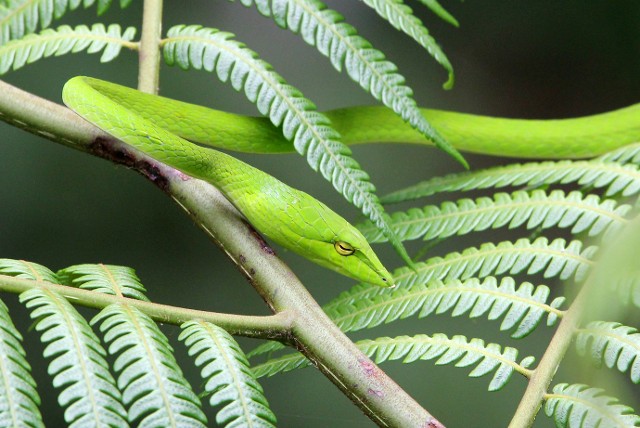
This Big-eye Whip Snake (Ahaetulla mycterizans) spent at least a few days on a giant tree fern right outside our room at the Halimun Research Station. He was glorious to watch.
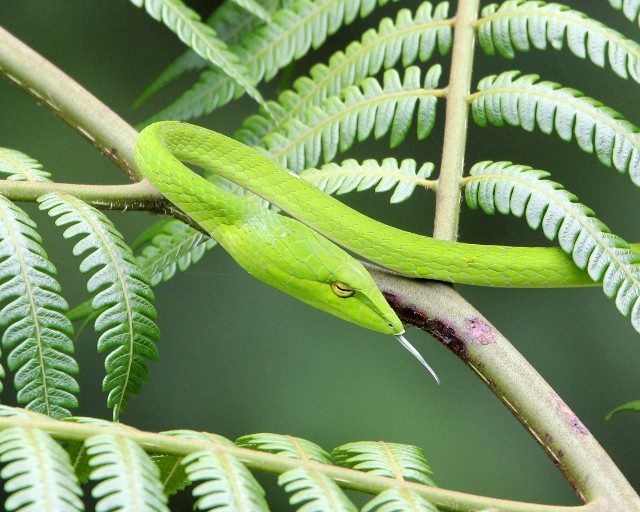
Big-eyed Whip Snake

Almost makes me want to become a herp-watcher!

Wow...
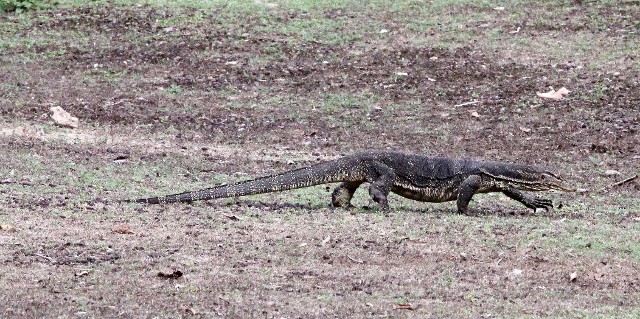
Very large Water Monitor Lizards are still found trekking the grounds of Peucang Island...
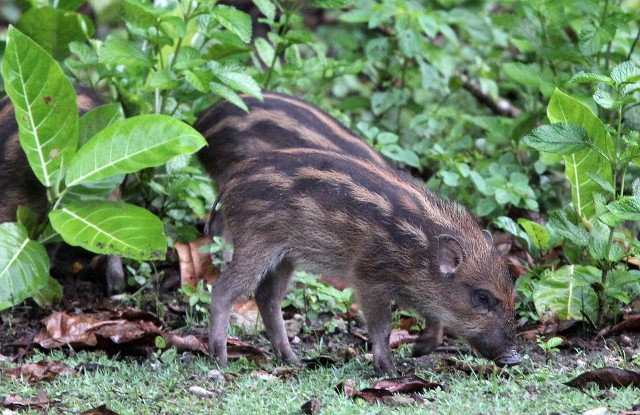
These little Sundaic Banded Pigs were SO cute! But I am sure the Water Monitor Lizards would find them to be a delicous snack!
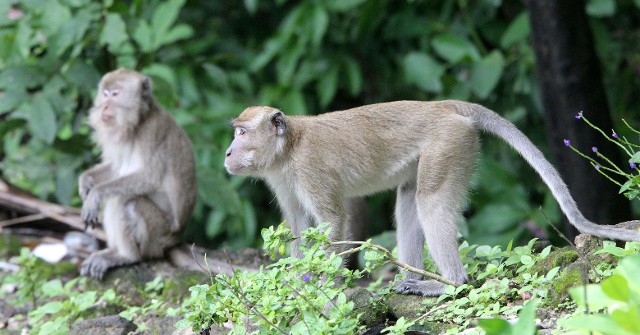
Long-tailed Macaques of Peucang Island!
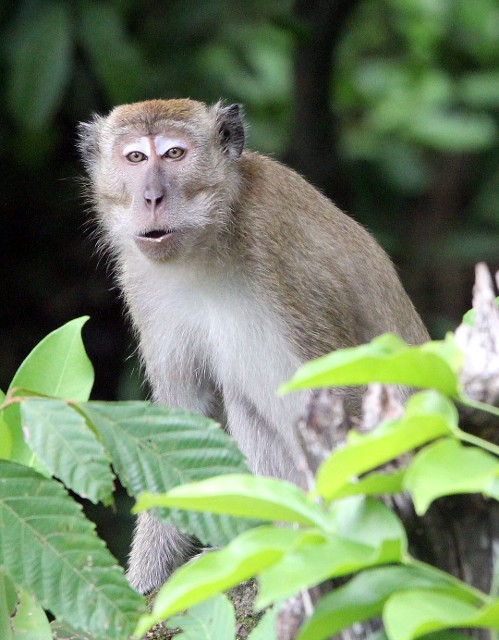
Long-tailed Macaque
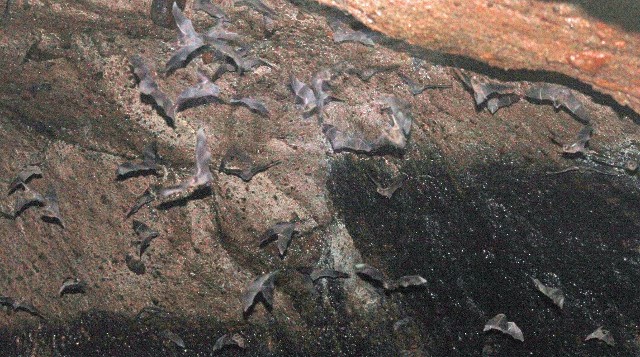
Schreiber’s Long-fingered Bat (Bentwing) (Miniopterus medius) were very numerous in one of the caves in Gunung Gede, but difficult to get to as it was flooded. There was at least one other species in the cave this day. Perhaps a Myotis species?

Indo-Pacific Bottlenose Dolphins were common, although difficult to photograph, in the seas surrounding Ujung Kulon. We also came across one Large-beaked Common Dolphin on the way to Krakatau Island.
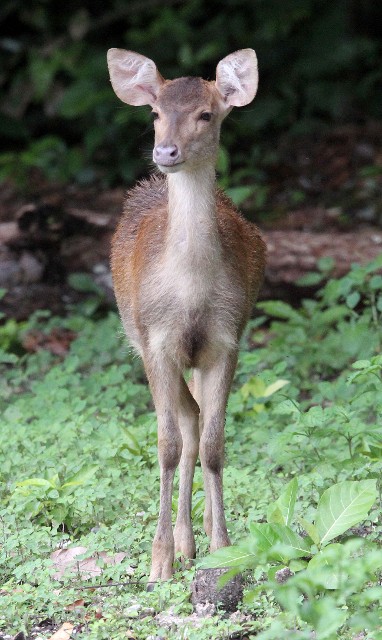
Javan Rusa at Peucang Island.
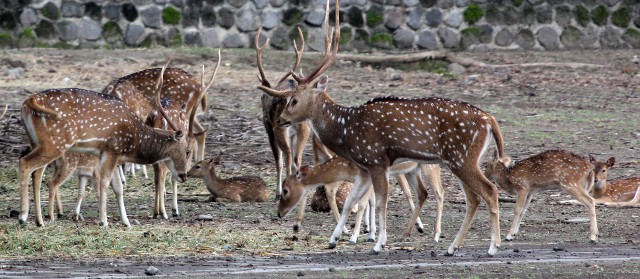
By no means wild, but there was a domestic herd of Axis Deer (Axis axis) at Prambanan Hindu Temple in Jogyakarta.
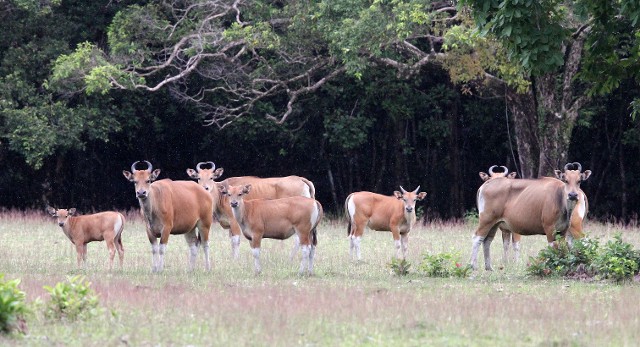
Javan Banteng in Ujung Kulon!
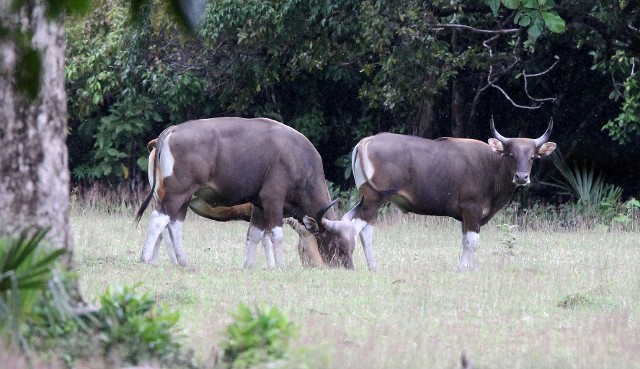
Javan Banteng bulls and their white socks...
Birds of Java Barat
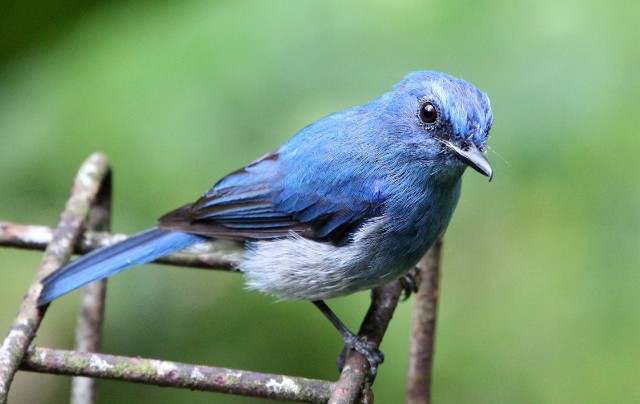
An Indigo (or Pale Blue) Flycatcher seen daily at Halimun Research Station.

Blue Whistling Thrush at Halimun.
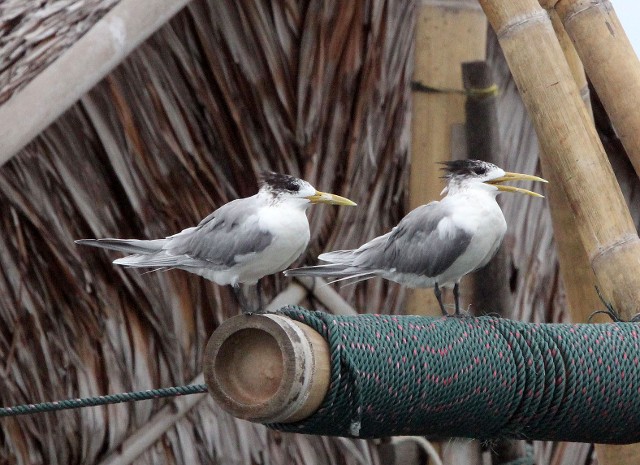
Great-crested Terns were very common in the seas surrounding Ujung Kulon.
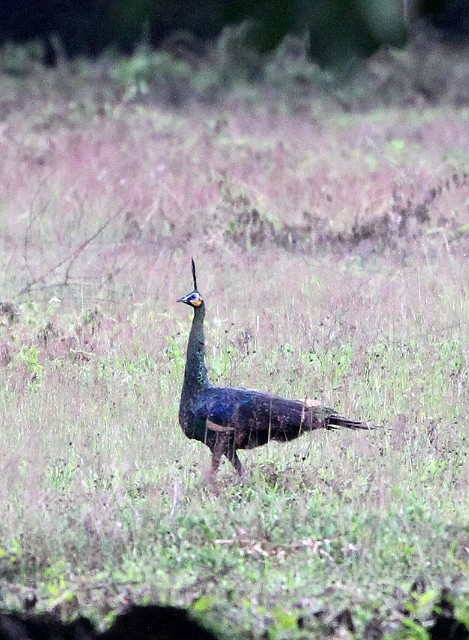
Green Peafowl are still very common in the grasslands of Ujung Kulon.
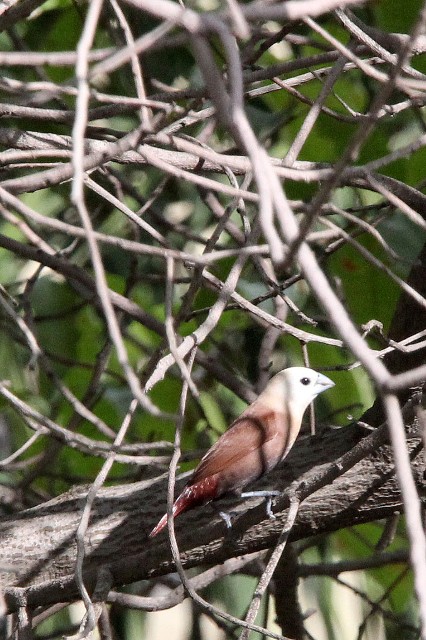
We came across many endemics in Java even though were only "lightly" birding on our trip. One of these endemics was the White-headed Munia, seen here.

This tiny little endemic Javan Tesia was called in by Indra's cell phone recording of its voice. He entertained us for several minutes along the trail at Halimun.

Hornbills were insanely common in Ujung Kulon. Although we were never able to get great pics, we saw at least 50 Oriental Pied Hornbills as well as a couple dozen Rhinoceros Hornbills and Wrinkled!

Pacific Reef Heron (Egret) at Ujung Kulon.

Little Heron in a stream at Ujung Kulon.
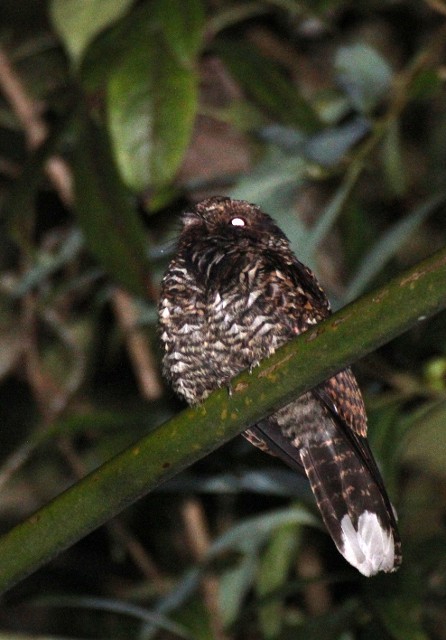
Javan Frogmouth at Halimun.

Lesser Forktail at Halimun Research Station.
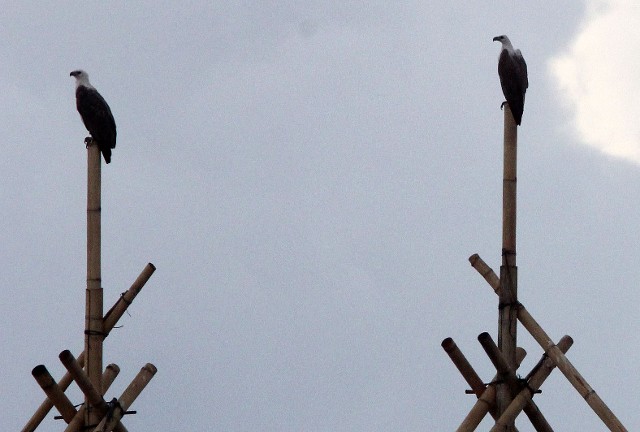
White-bellied Sea Eagles stationed on a shrimp station in Ujung Kulon.
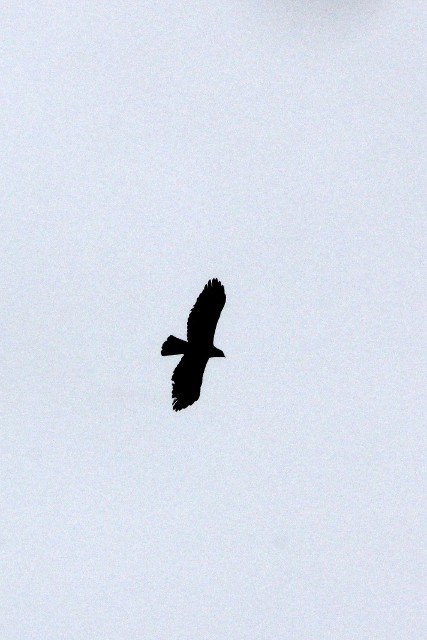
There were always endemic Javan Hawk Eagles soaring above the Halimun Reseach Station.

Crested Serpent Eagles were another common raptor in Java Barat. This one was spotted in the tea plantations of Halimun.

Lesser Racket-tailed Drongo at Halimun.

Grey-cheeked Bulbul at Gunung Gede.
Java Bird List
- Lesser Frigatebird*
- Cattle Egret
- Little Egret
- Pacific Reef Egret
- Little Heron
- Javan Pond Heron
- Little Cormorant
- Oriental Darter
- Crested Serpent Eagle
- Javan Hawk Eagle*
- White-bellied Fish Eagle
- Green Peafowl
- Common Sandpiper
- Common Greenshank
- Great-crested Tern (Sterna bergii)*
- Black-naped Tern*
- Dark-backed Imperial Pigeon*
- Rock Pigeon
- Chestnut-bellied Malkoha*
- Lesser Coucal
- Glossy Swiftlet
- Orange-breasted Trogon*
- Common Kingfisher
- Stork-billed Kingfisher
- Rufous-collared Kingfisher*
- Lesser Forktail*
- Rhinoceros Hornbill
- Wreathed Hornbill (check for Java)
- Pied Hornbill
- Crimson-winged Woodpecker*
- Sunda Minivet*
- Blue-winged Leafbird
- Grey-cheeked Bulbul*
- Lesser Racket-tailed Drongo
- Ashy Drongo
- Blue Nuthatch*
- Magpie Robin
- Sunda Blue Robin*
- Blue Whistling Thrush*
- Siberian Thrush
- Spotted Crocia*
- Javan Fulvetta*
- Javan Tesia*
- Plain Prinia
- Asian Brown Flycatcher
- Indigo Flycatcher
- Pale Blue Flycatcher (check with images)
- Javan Myna*
- White-flanked Sunbird*
- Oriental White-eye*
- Javan Munia*
- White-headed Munia*
- Chestnut Munia*
- Eurasian Tree Sparrow
- Grey-rumped Treeswift*
- Javan Frogmouth*
- Sumatran Green Pigeon*
- Some sort of bee-eater…
*At least 20 lifers!
More Stuff

A spectacular Damselfly at Halimun.

A massive garden spider in Halimun.

A cryptic frog seen in a stream at Halimun.
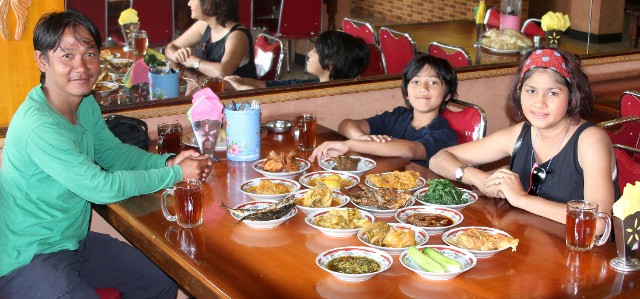
I wanted to make sure that Som and Cokie had a chance to try Masakan Padang, one of the most popular food styles in Indonesia. Originating in Sumatra, you can pretty much find it anywhere in Indonesia these days. You basically pay for what you eat. Touch it and you bought it!

Wanted to also make sure that Som could try some goat brain! Yum!

One of the highpoints of Indonesian cuisine is the fresh seafood! We pigged out for about a week in Ujung Kulon and Carita Beach with prawns, fresh fish and other delicacies from the sea...
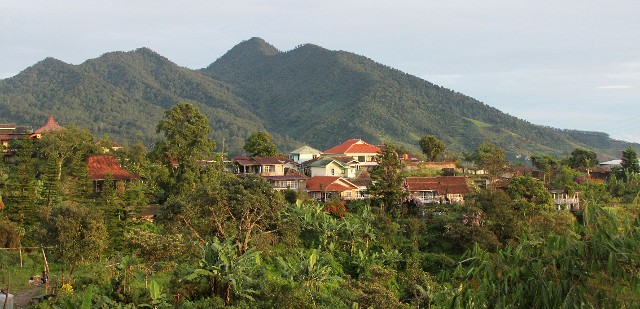
Our view from the lovely Inkara Lodge at Cibodas, just outside Bogor and Gunung Gede National Park. Great place to stay!

The view of Java Barat from Bogor.
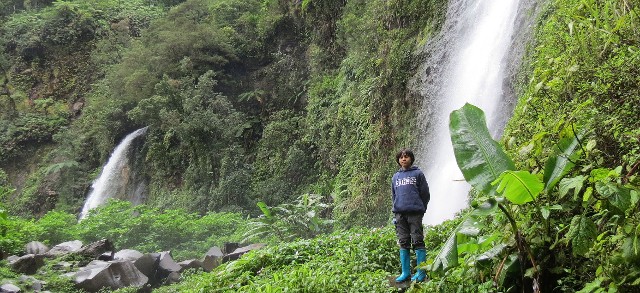
Cibodas Waterfalls at Gunung Gede National Park, Java Barat.
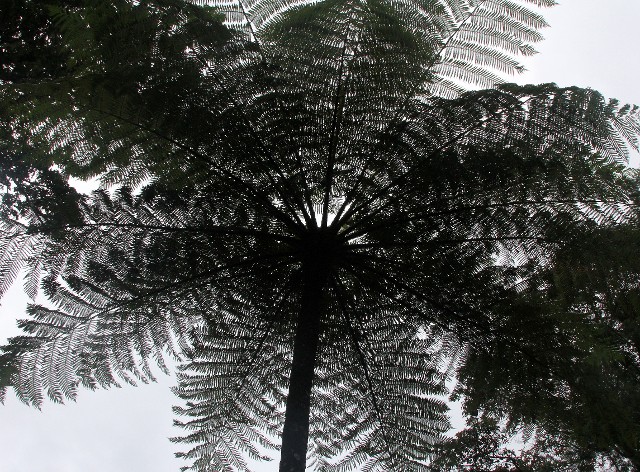
Gunung Gede National Park was filled with the largest giant tree ferns I'd ever seen.

Searching for Javan Gibbons at Gunung Gede...None were seen this day...

Thankfully Merapi Volcano was not erupting during our stay in "Jogja"!
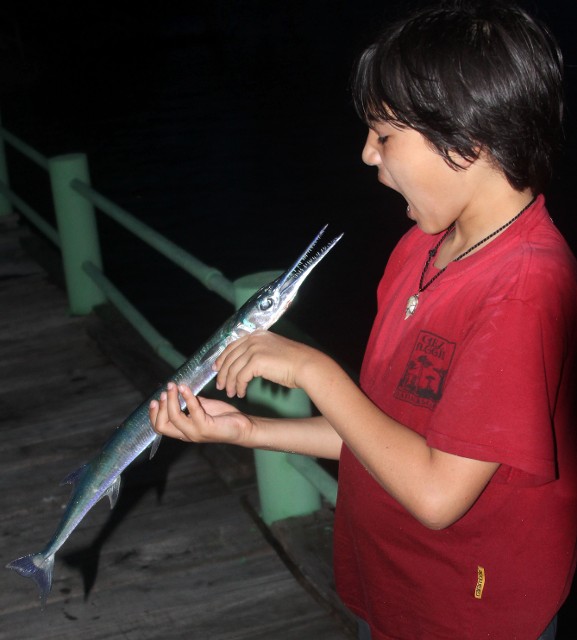
Cokie and his pet Barracuda! (Actually a "Houndfish"...but the locals called it a Barracuda...)
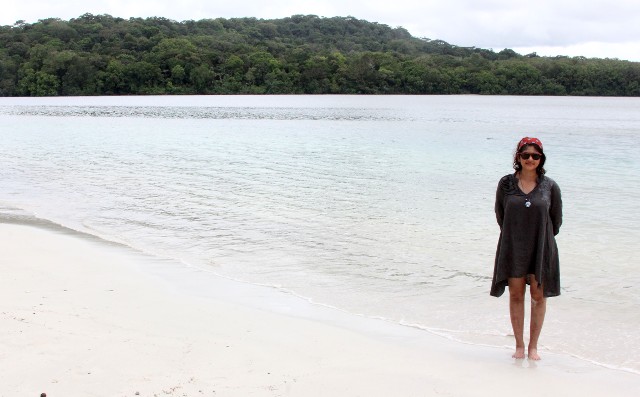
Ujung Kulon is home to some of the nicest beaches anywhere! And there is NO ONE there to bother you!
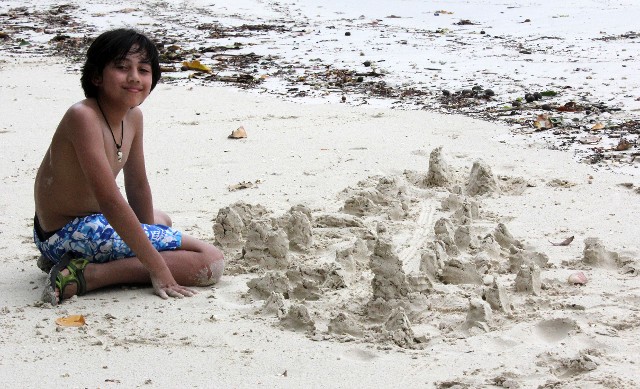
Cokie got in some quality "city-building" time in at Ujung Kulon...

Dinner at Ujung Kulon! Pretty sweet grub actually!
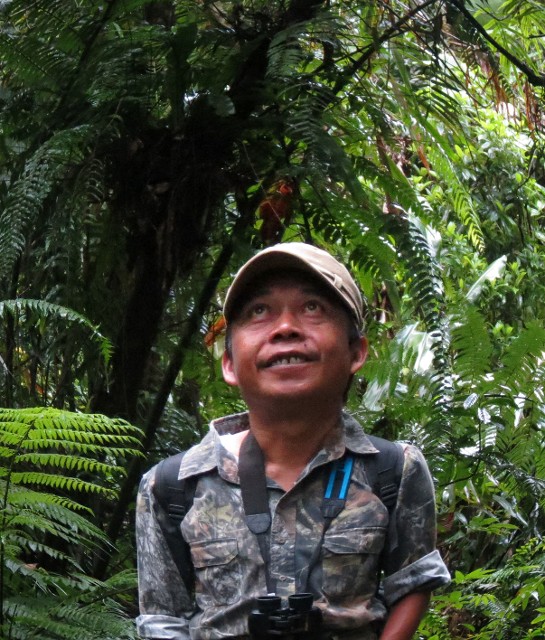
"Eddy", our faithful guide in Gunung Gede
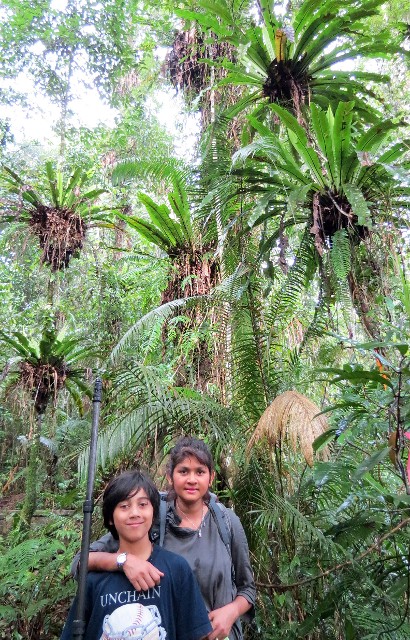
Halimun and Gede are home to astounding botanical biodiversity!
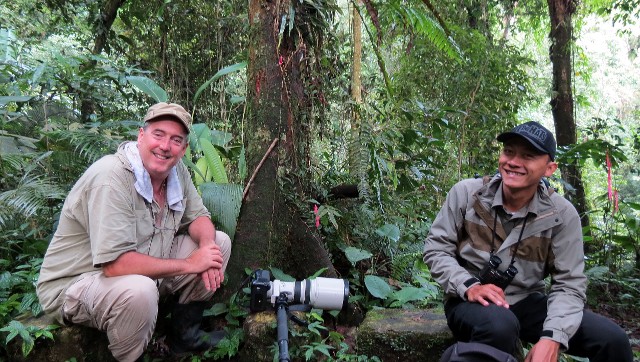
Indra, our outstandingHalimun guide, and Coke enjoying a rest at one of the summits in Halimun...hoping for a Black-eared Pygmy Squirrel or two to show themselves....(they didn't)
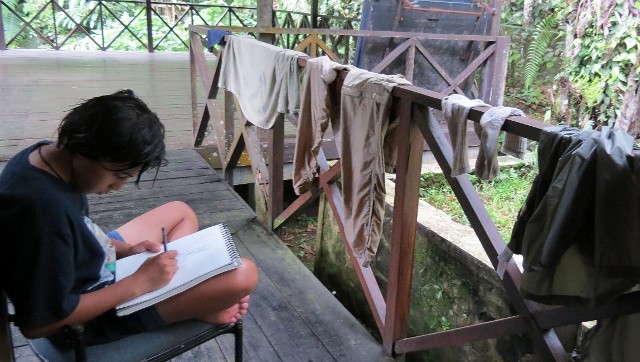
Cokie sketching and watching the laundry dry at Halimun Research Station...

Birdwatching at Halimun Research Station...
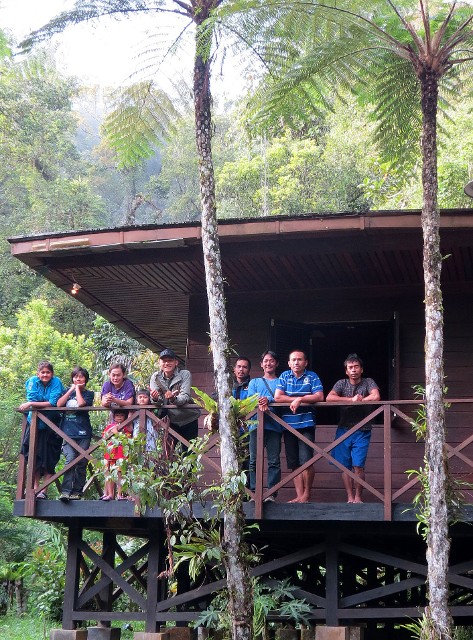
Team Halimun!
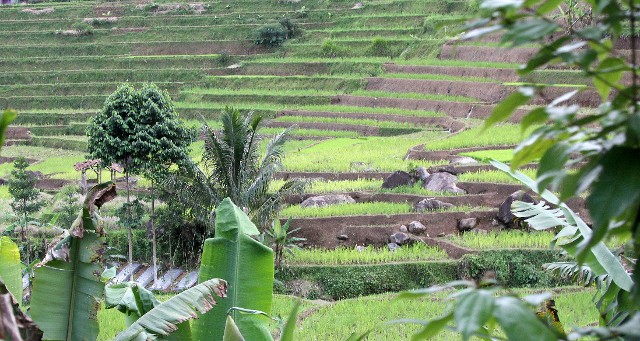
The countryside on the way to and around Halimun is actually quite beautiful...
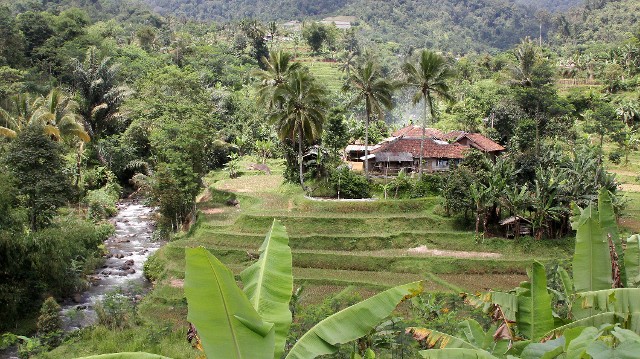
Halimun village scene...

Coke and Indra trying to figure out what the heck is in the picture!
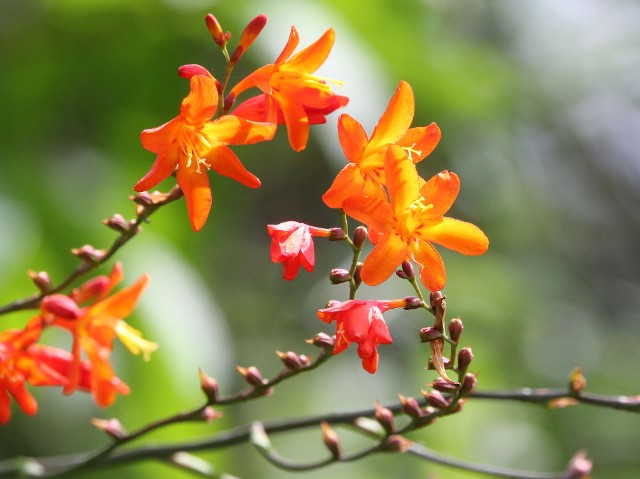
Orchids of Halimun...
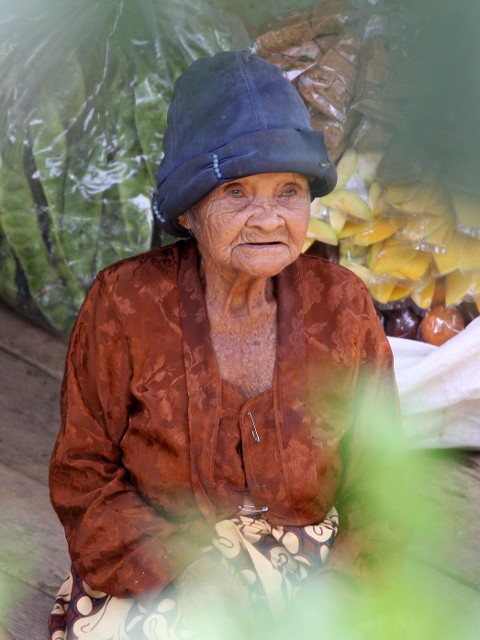
Old woman in Halimun Village
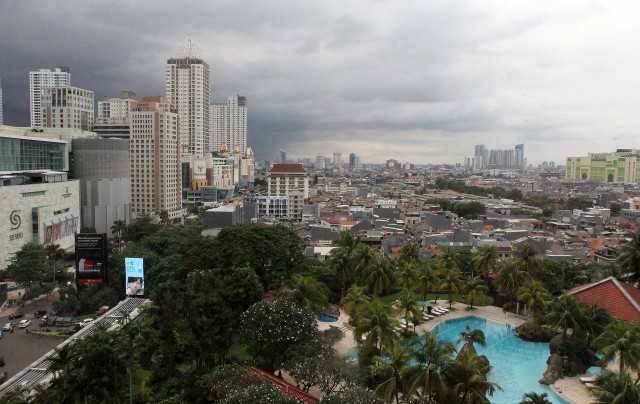
Our view from the Jakarta Grand Hyatt!
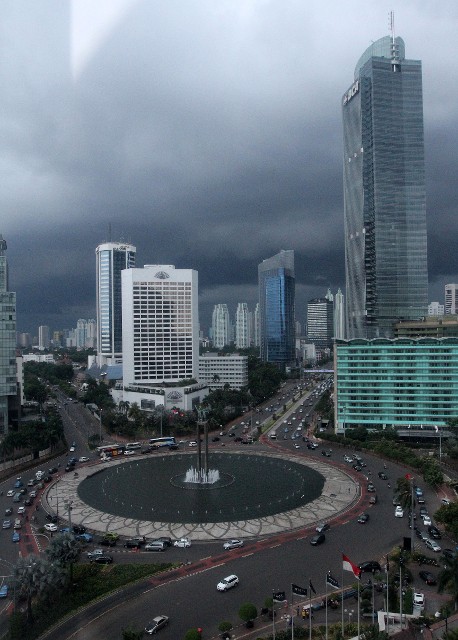
Jakarta!

I feel pretty lucky that our stay in Jakarta was not two weeks later when the serious floods started. Here is the view from our hotel during the peak of the floods! (Images from UPI)

Note the Grand Hyatt in the upper right...
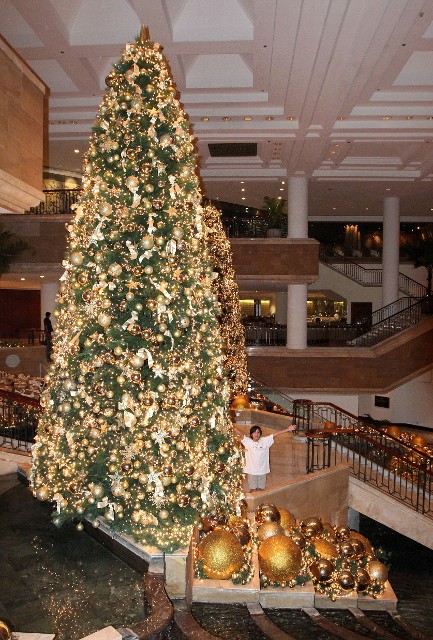
Grand Hyatt lobby....After all of the "roughing it", we had to treat ourselves to something special....Merry Christmas!
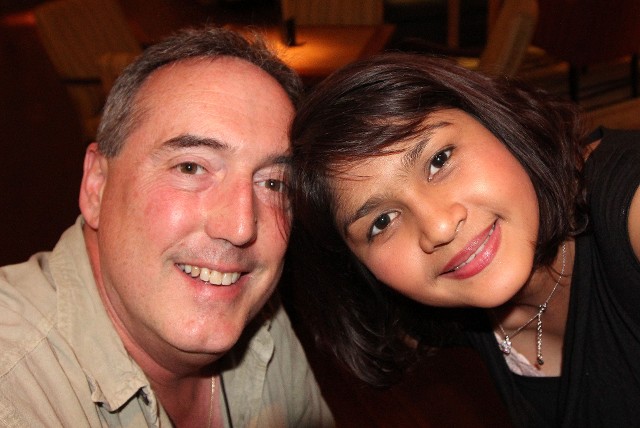
December 21, 2012: ELEVEN years of marriage! Our anniversary dinner at the Grand Hyatt, Jakarta! What a great night!
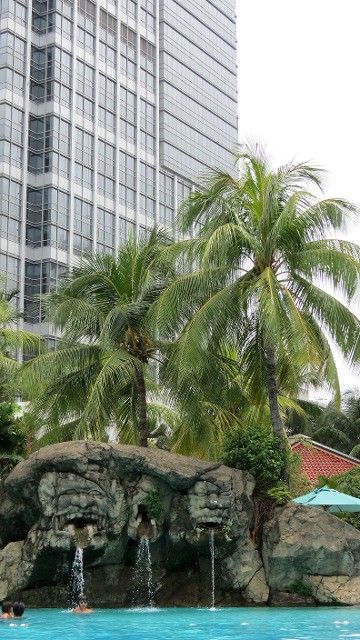
Cokie loved swimming in the gigantic pool at the Grand Hyatt...

Breakfast at the Phoenix Hotel in Jogja! What a lovely old hotel - once the president's home.
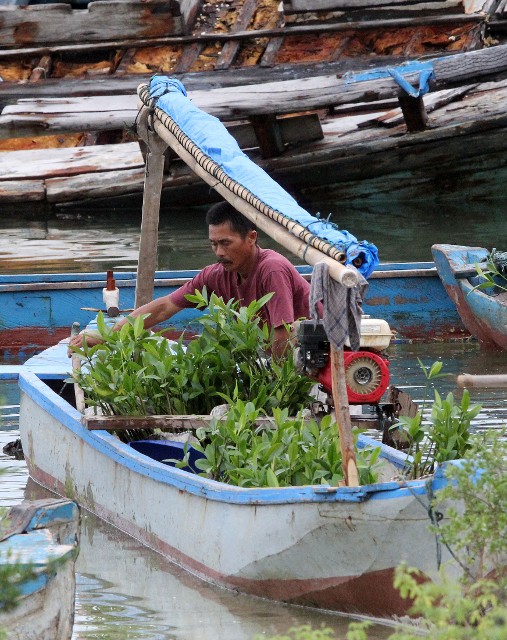
Interestingly, with all of the environmental destruction and neglect in Indonesia, you can sometimes find little vestiges of hope.... In Ujung Kulon, they are actively replanting mangrove forests.
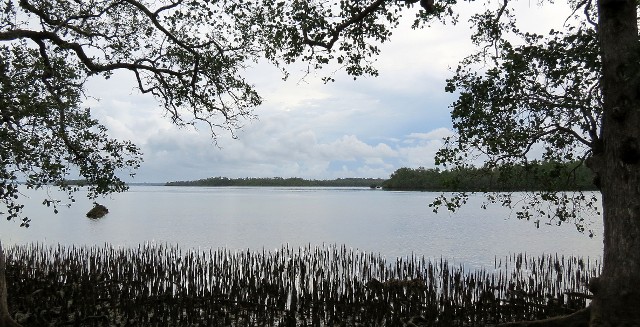
The mangrove forests of Ujung Kulon!

Passiflora species seen along the trail in Ujung Kulon...

Some great treks were had on this expedition. This was through one of the wider portions of the Ujung Kulon trek to "Rhino Central".
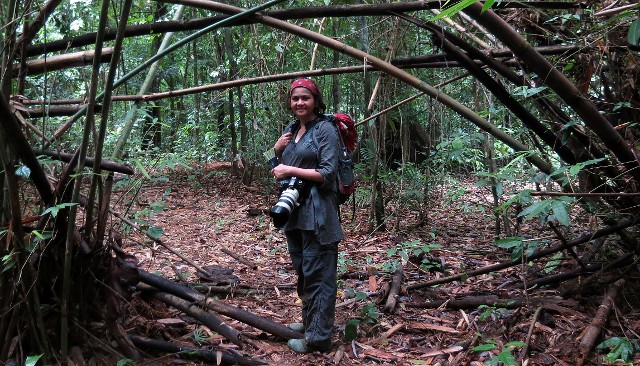
Bamboo thicket of Ujung Kulon...

Giant old Ficus in Ujung Kulon...

My son the fish....
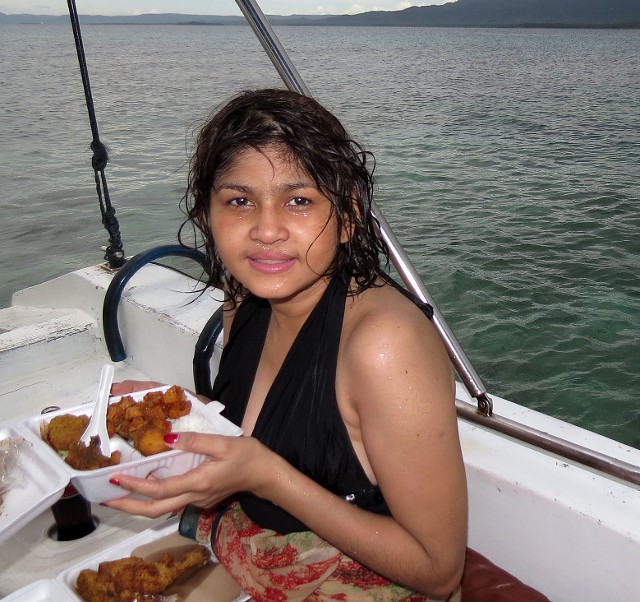
Lunch on the boat!
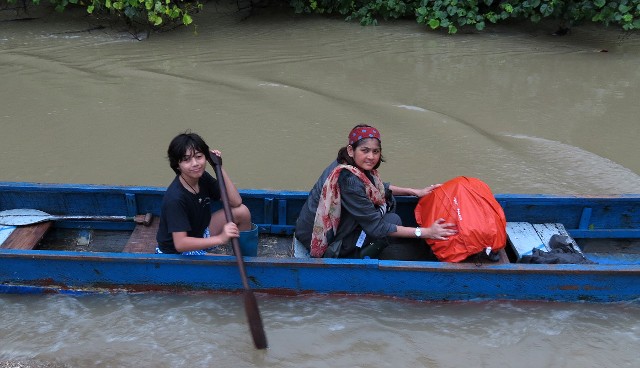
Cokie taking Som to see some Rhinos at Ujung Kulon!

Borobudur Temple
Please check out our Pbase galleries for more images of Indonesia!
Mammals of Java Barat
Birds of Java Barat
People & Places of Java Barat
Other critters of Java Barat
***
Here is s good link for information on the fauna of Ujung Kulon
http://www.krakatautour.com/ujung-kulon-fauna.htm
Interesting website on the amazing number of Wild Boar subspecies/”races”
http://en.wikipedia.org/wiki/Wild_boar
